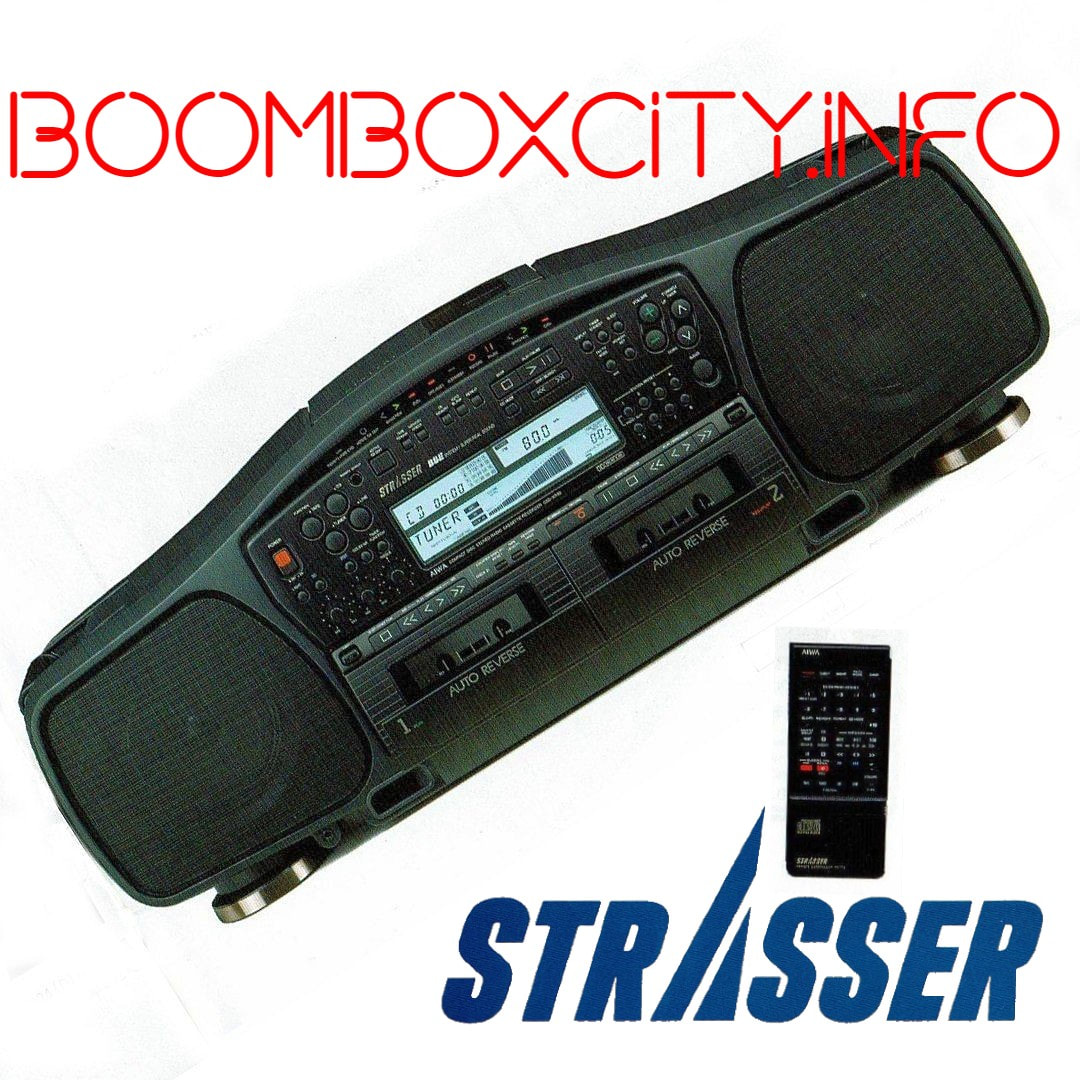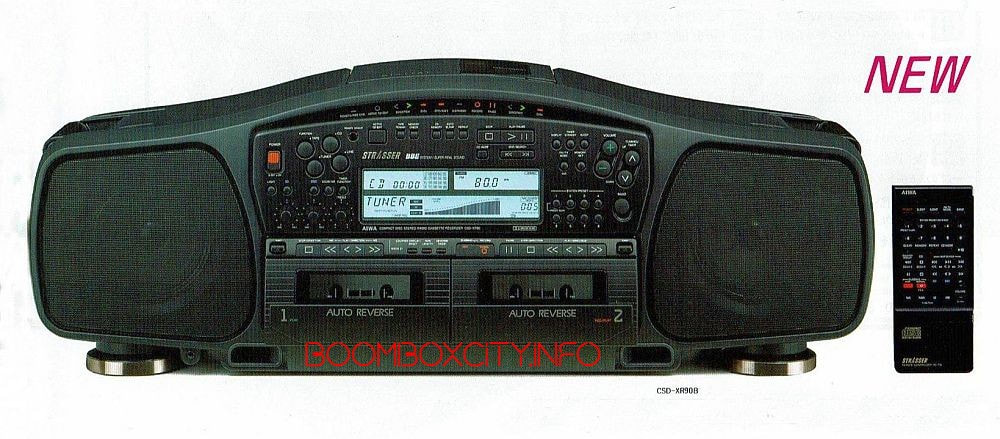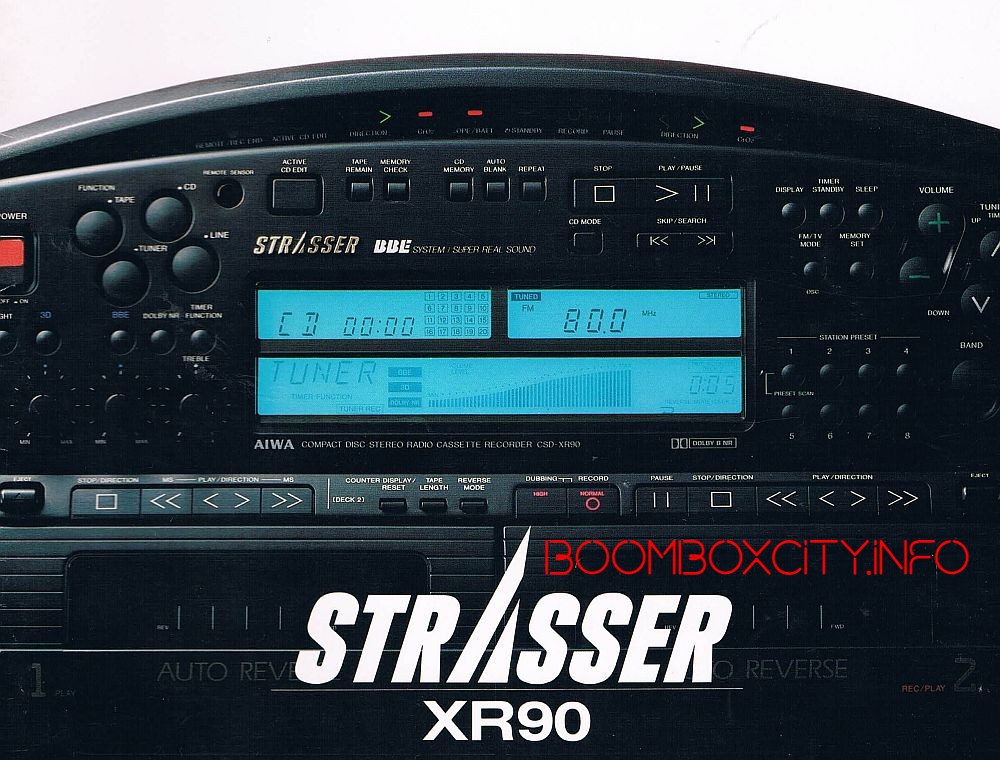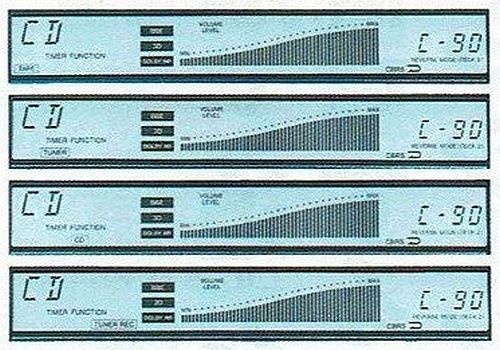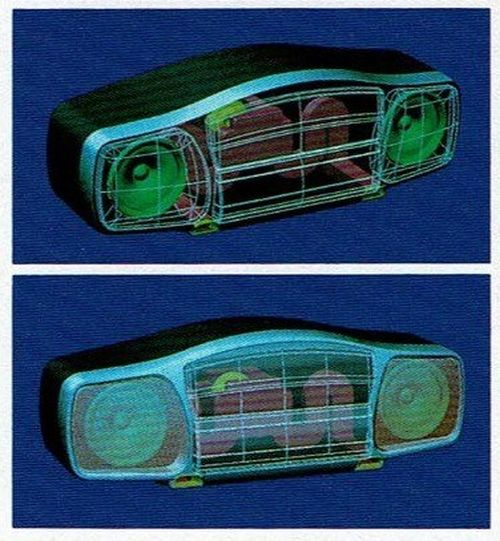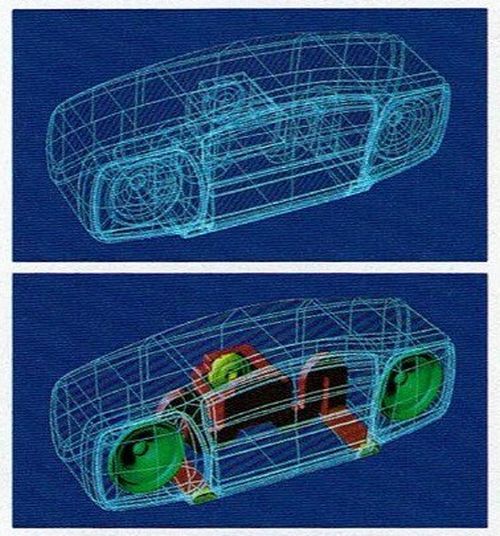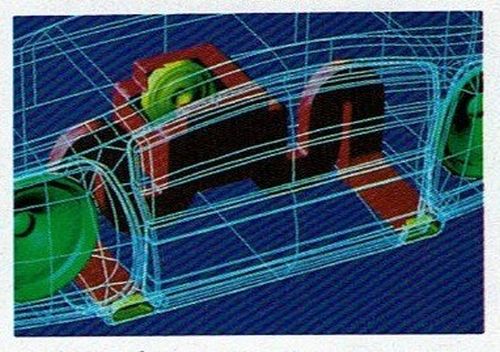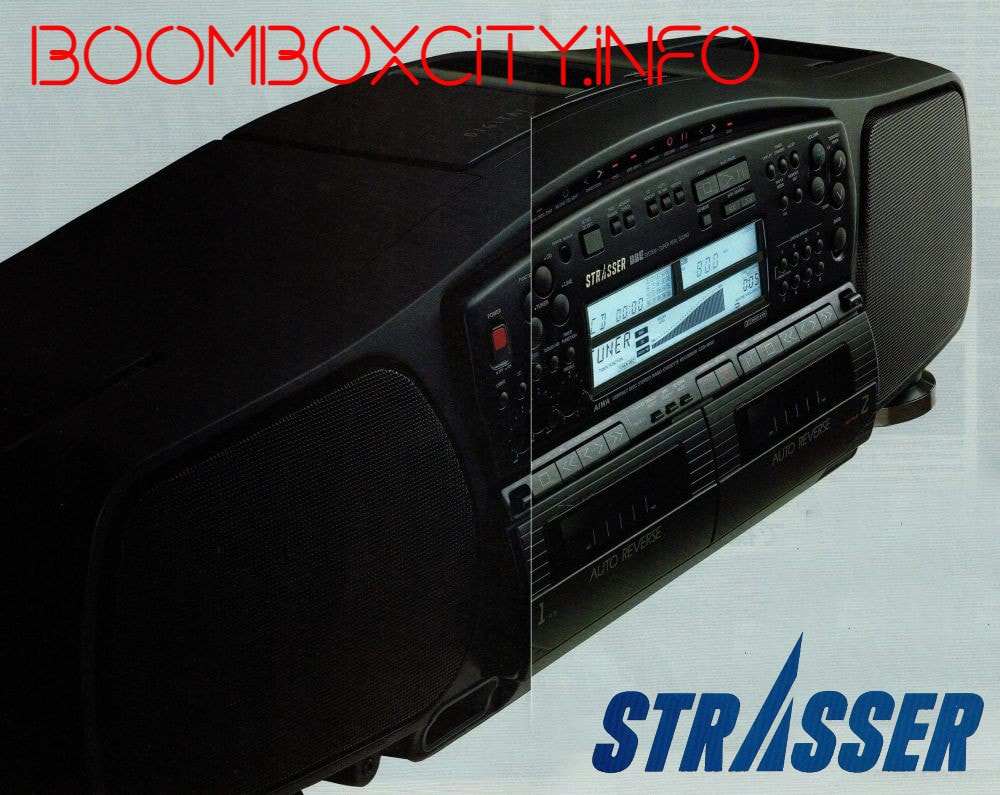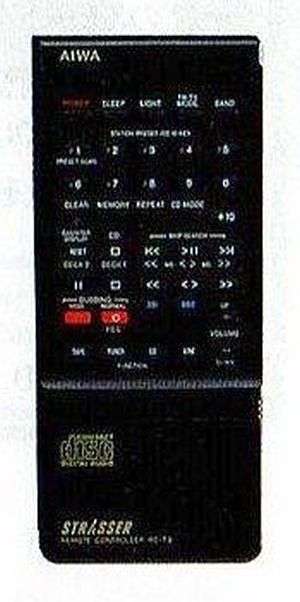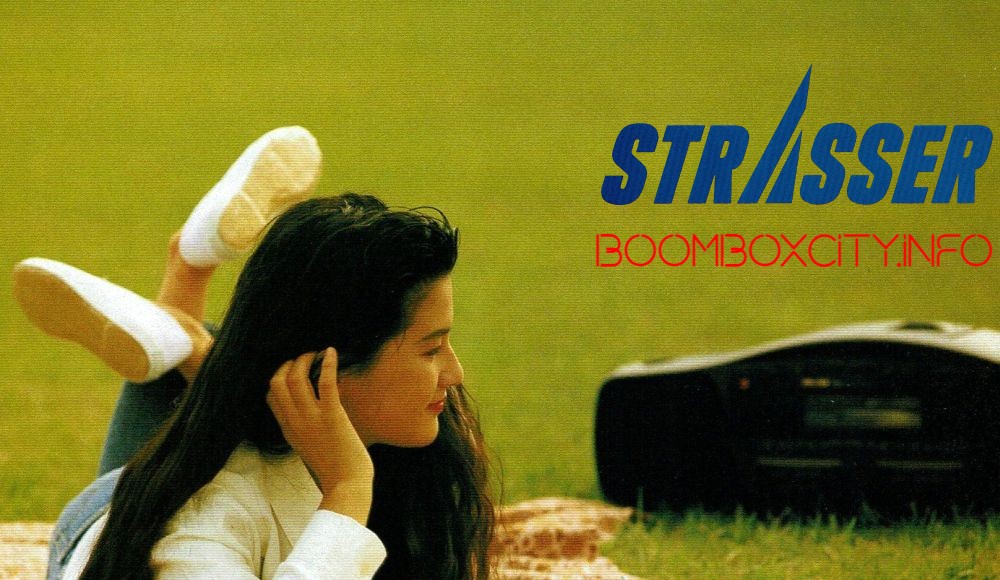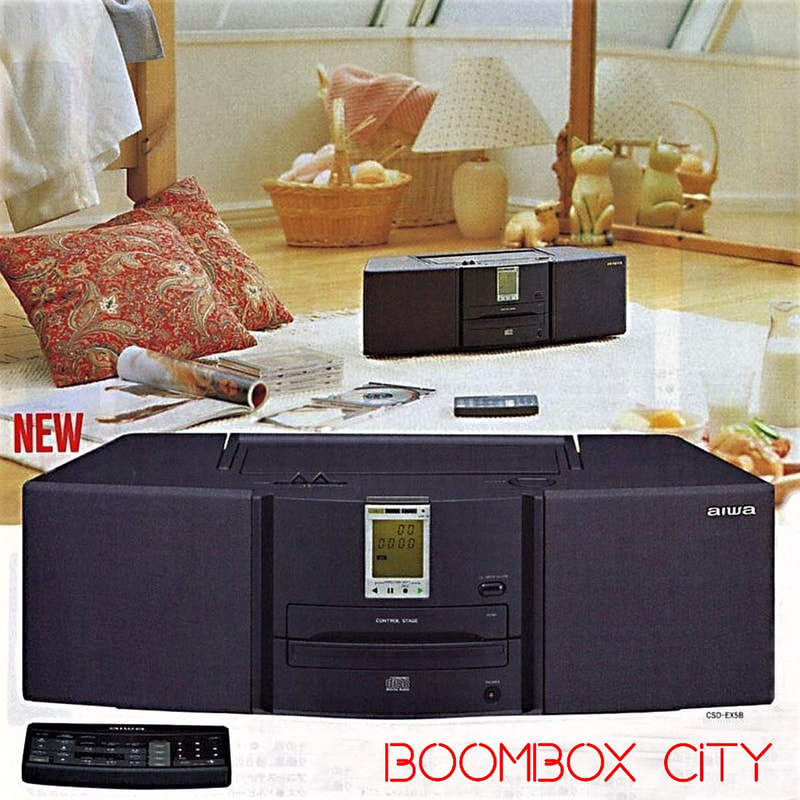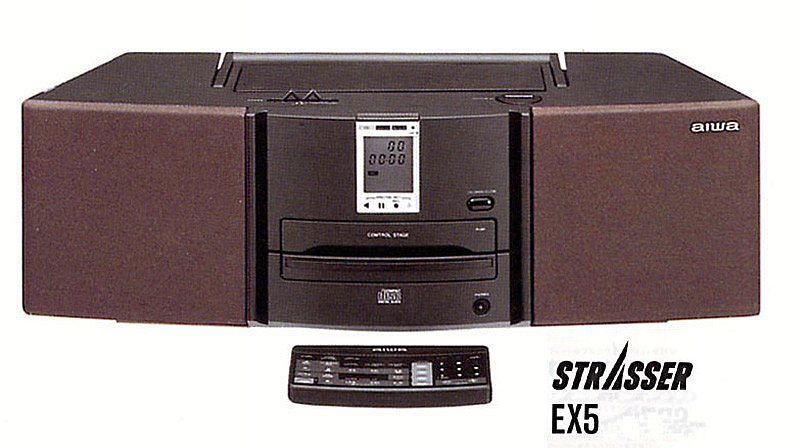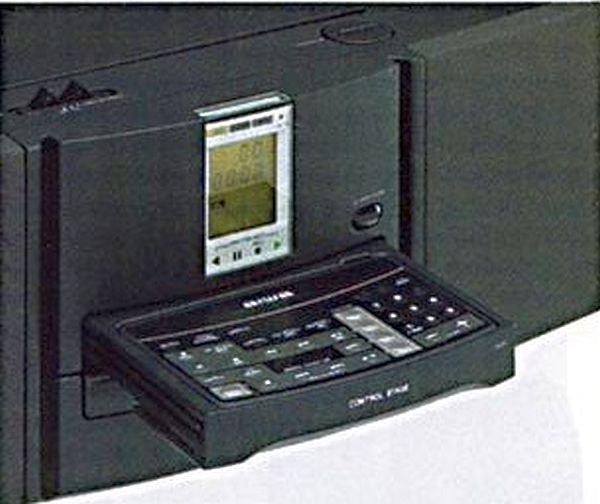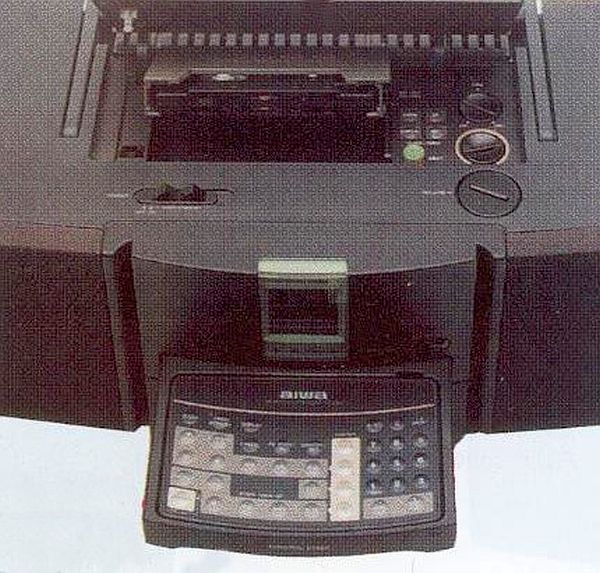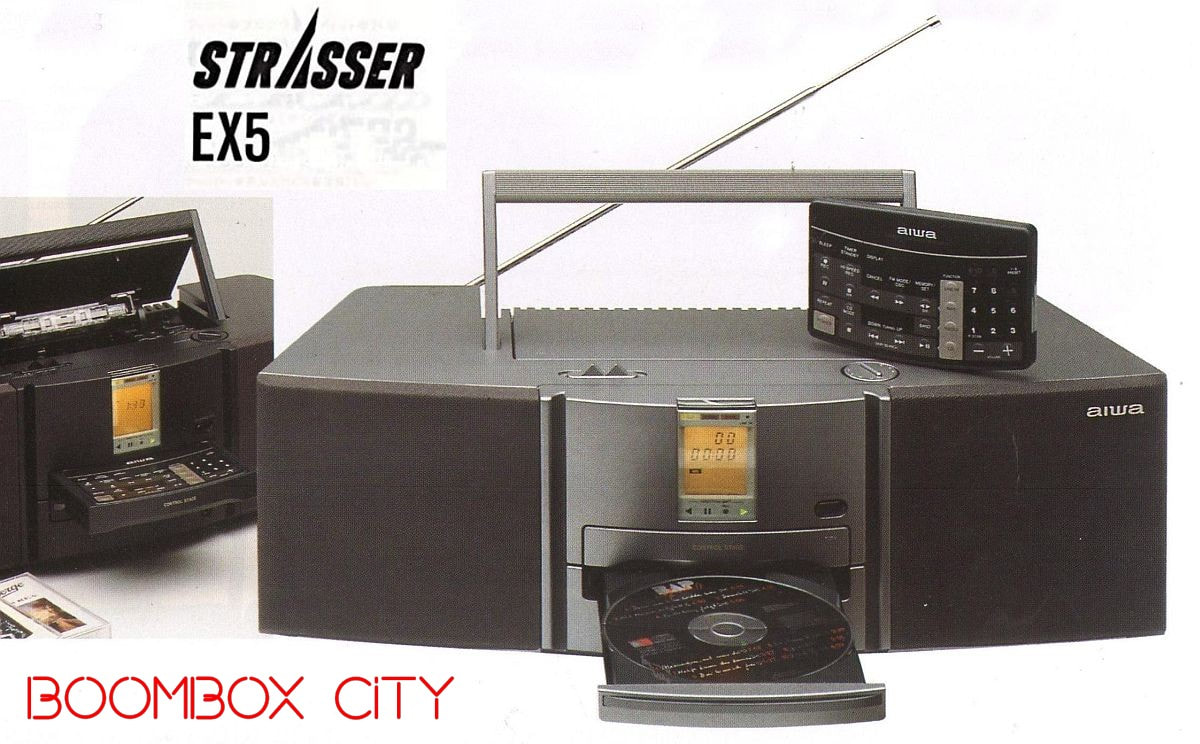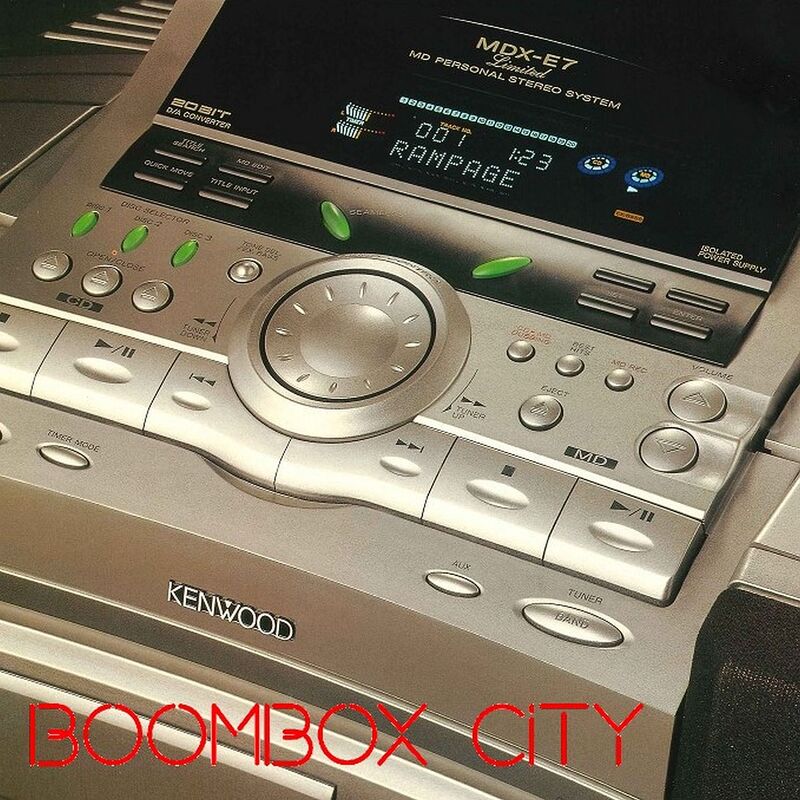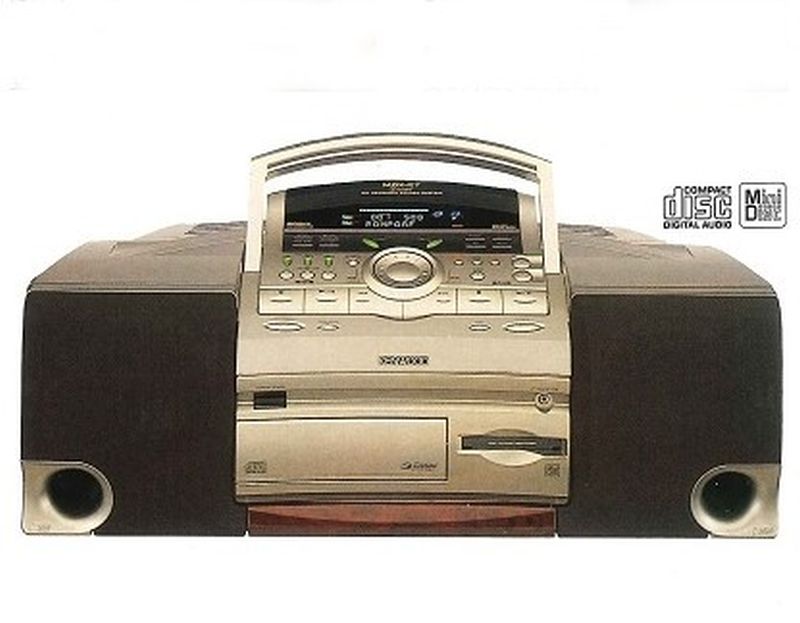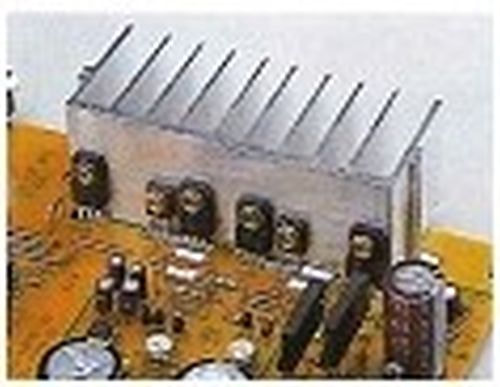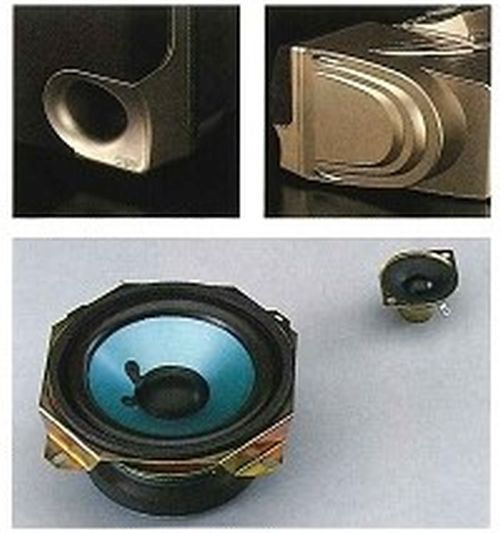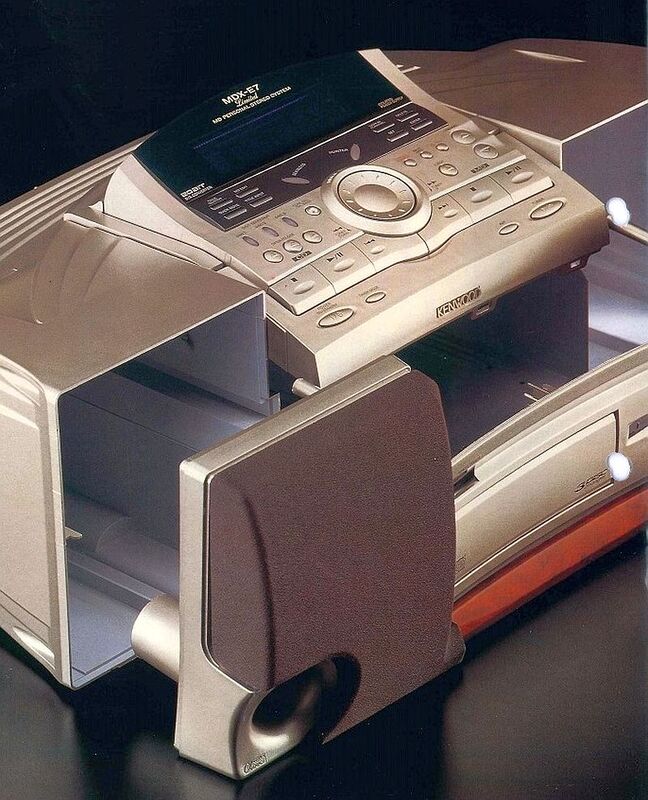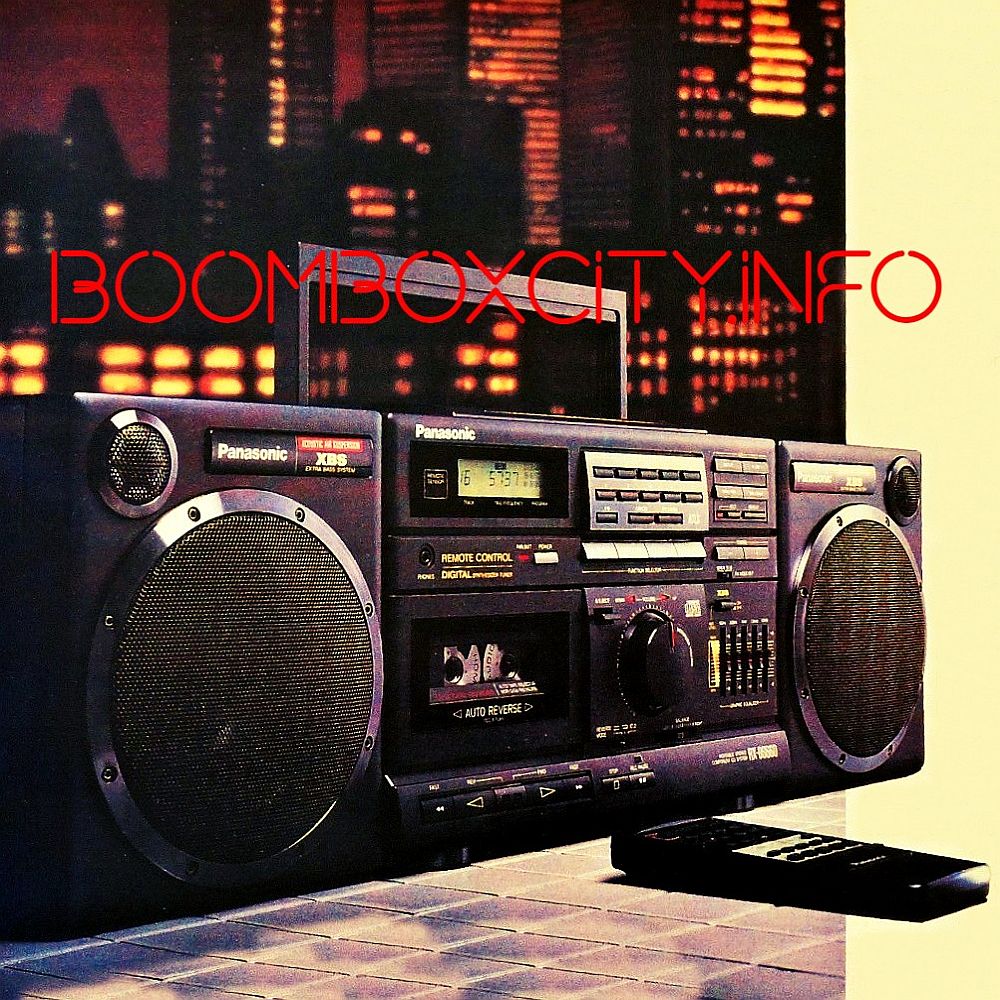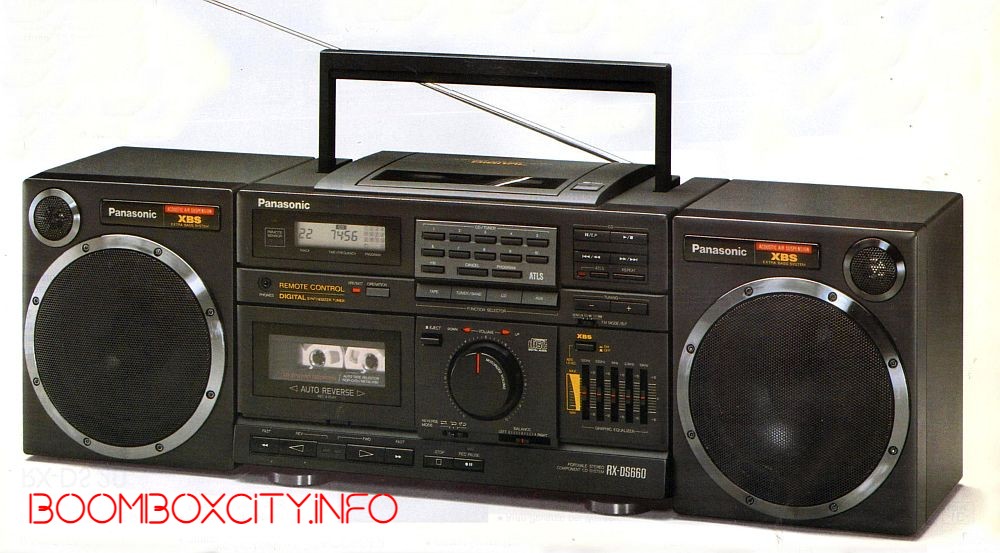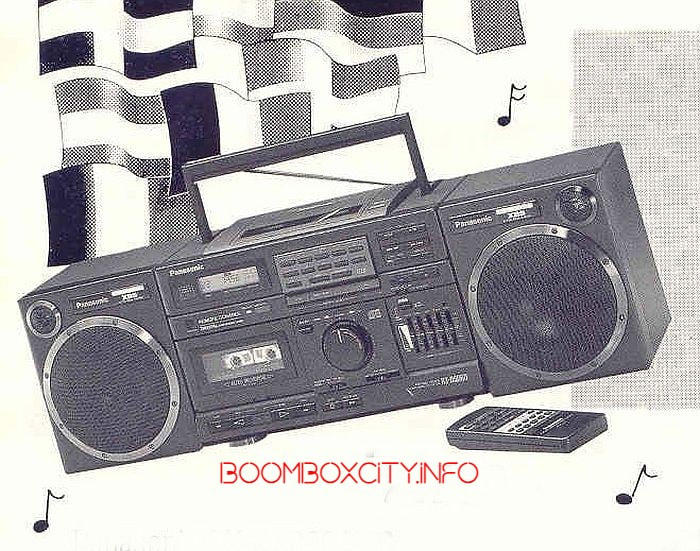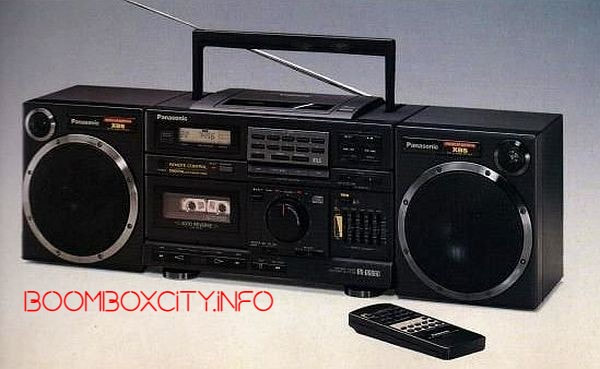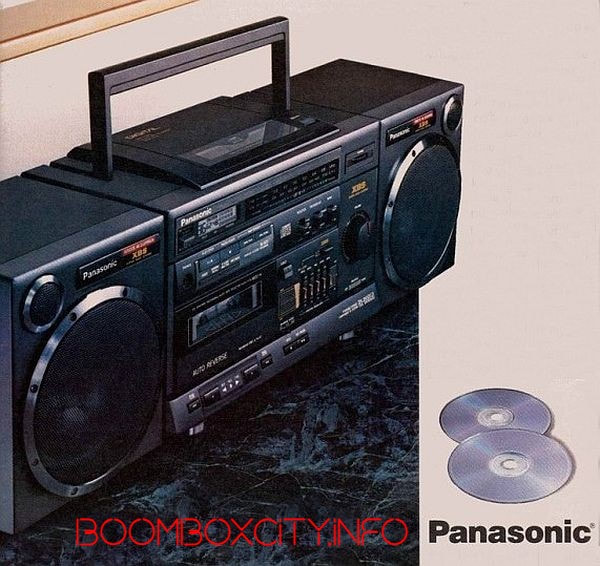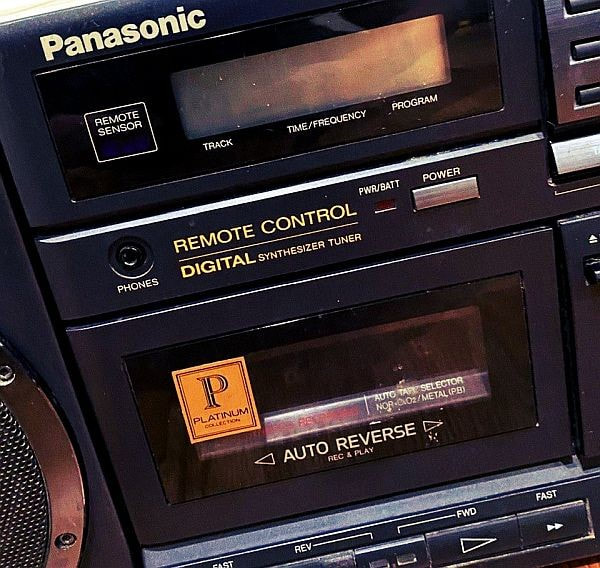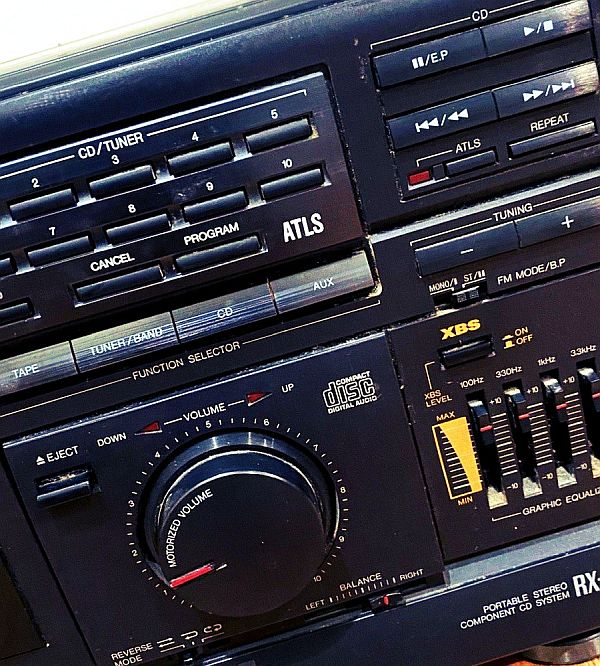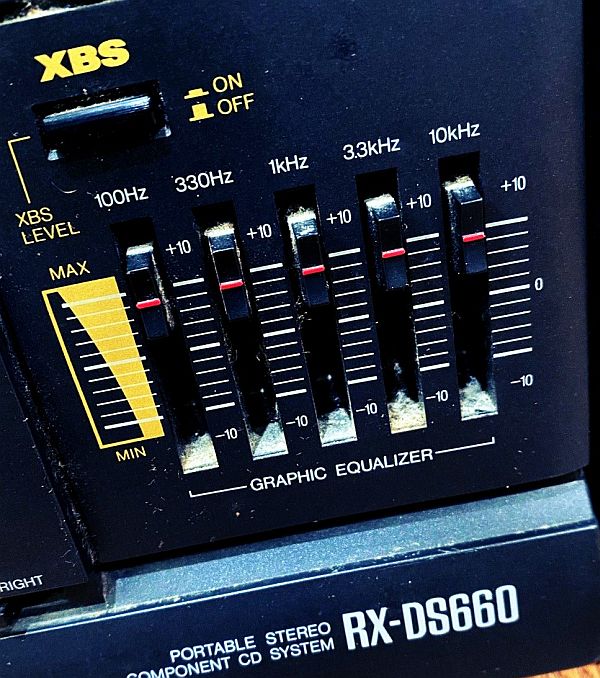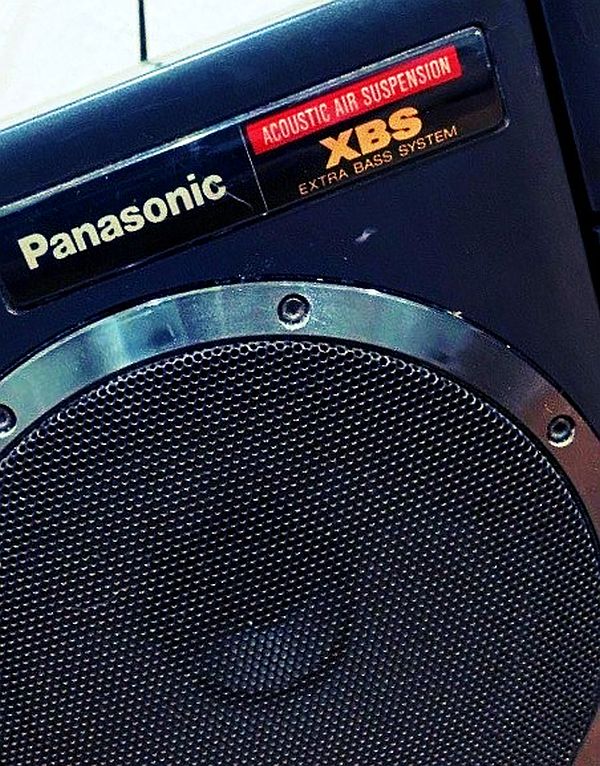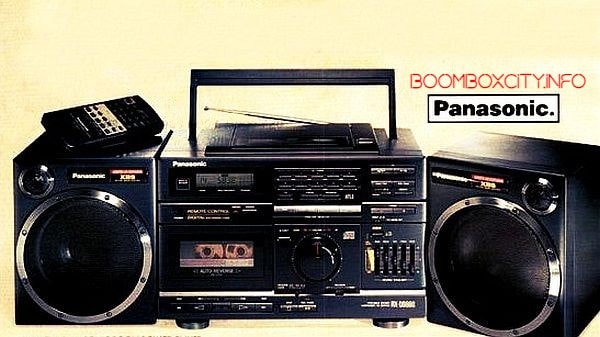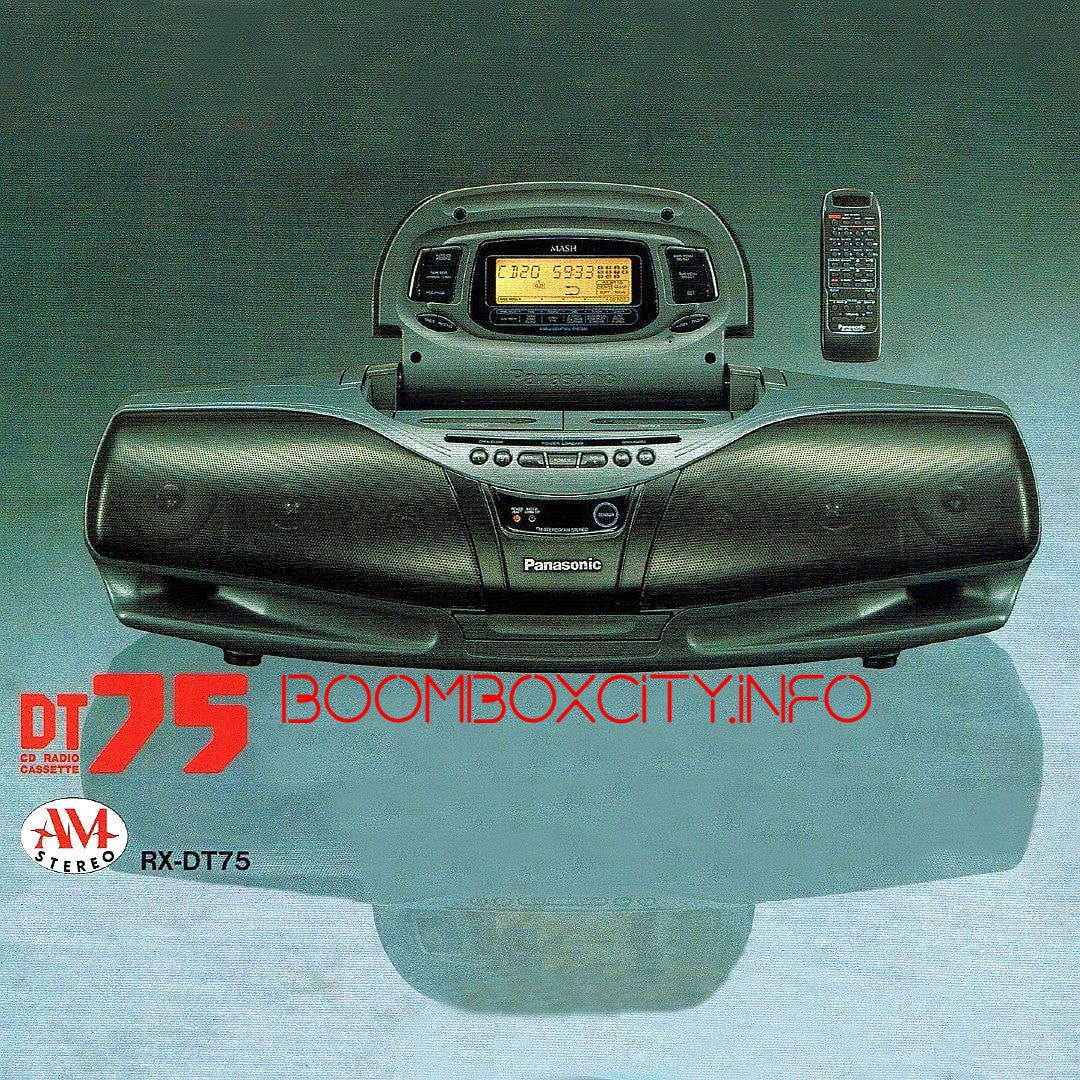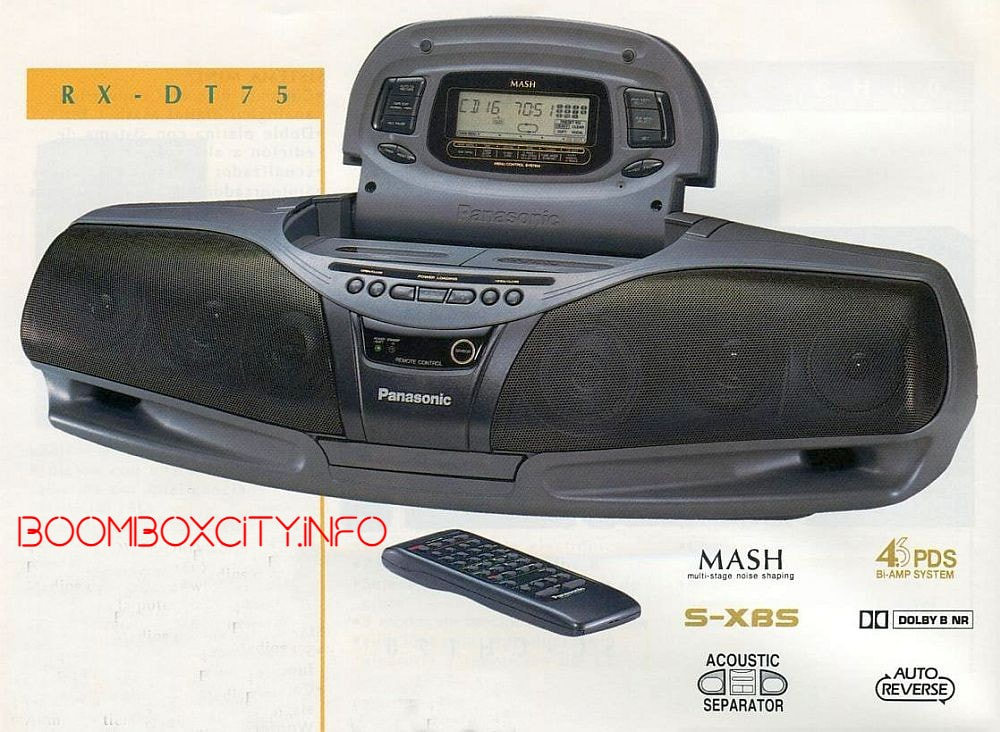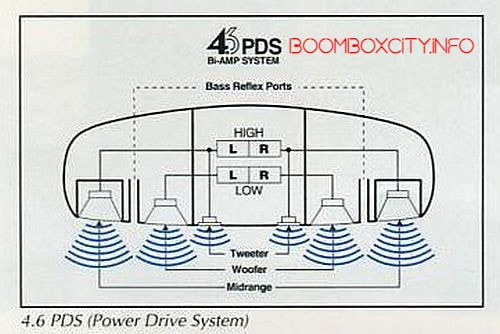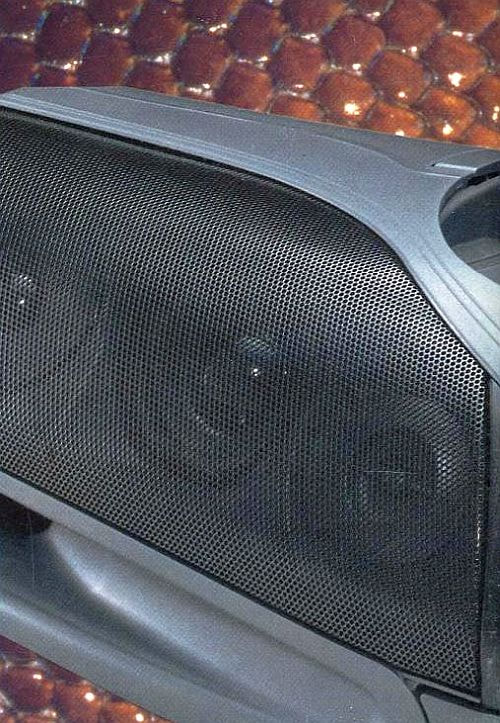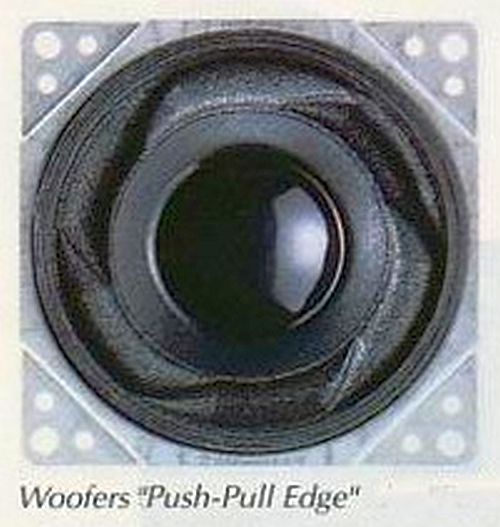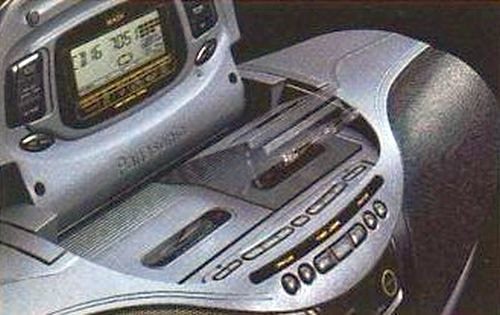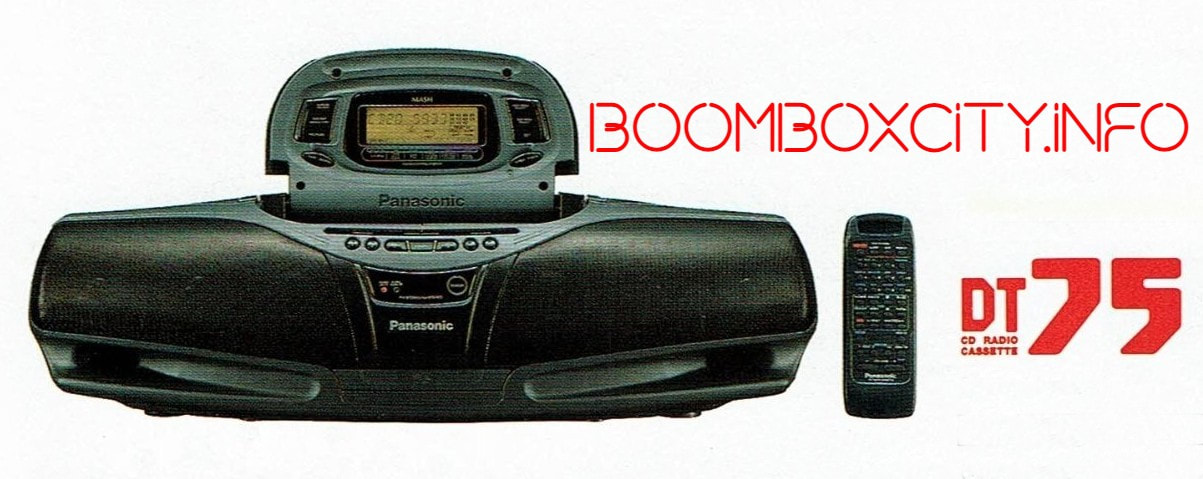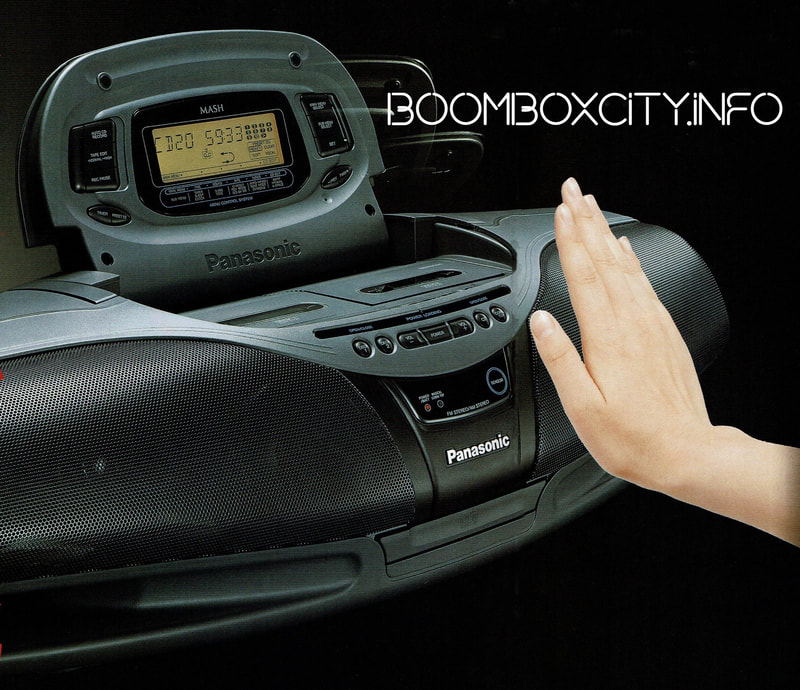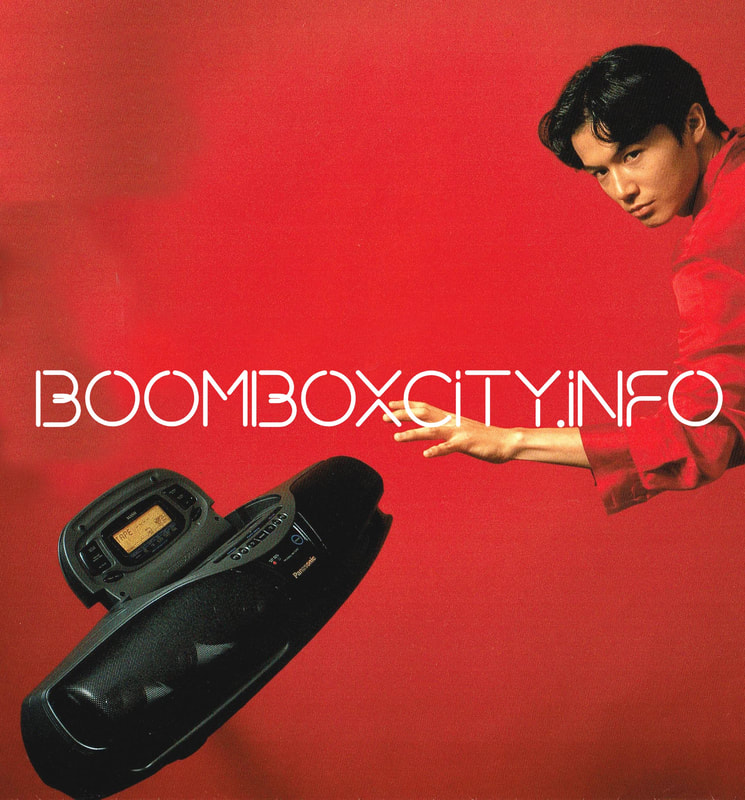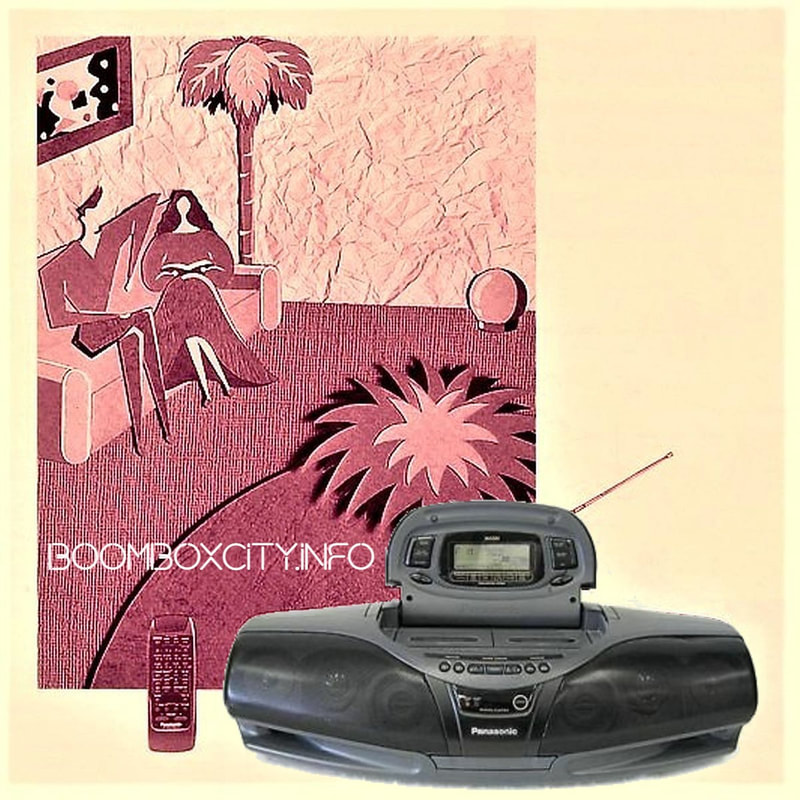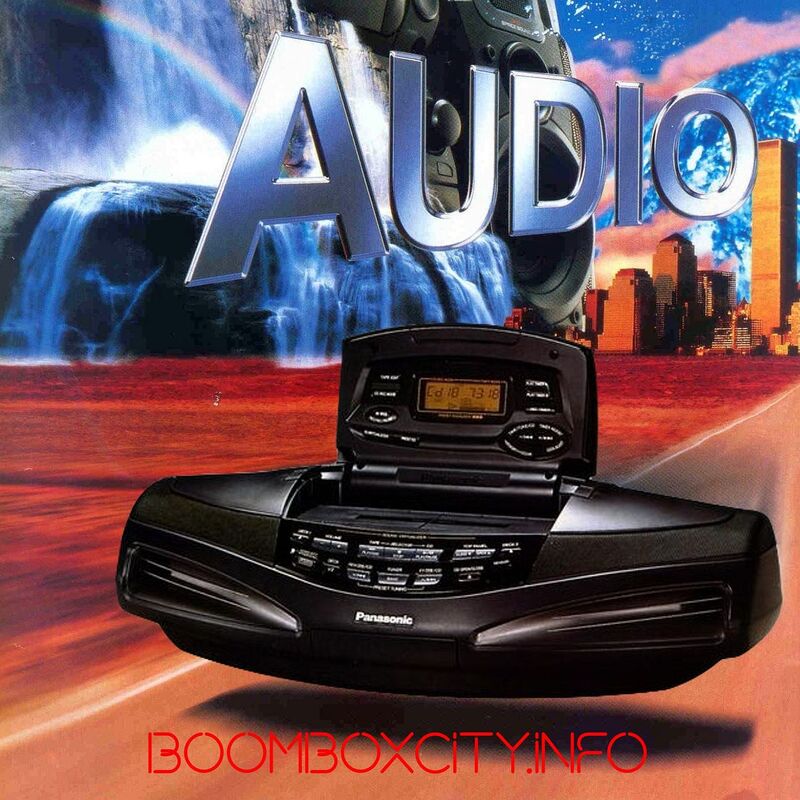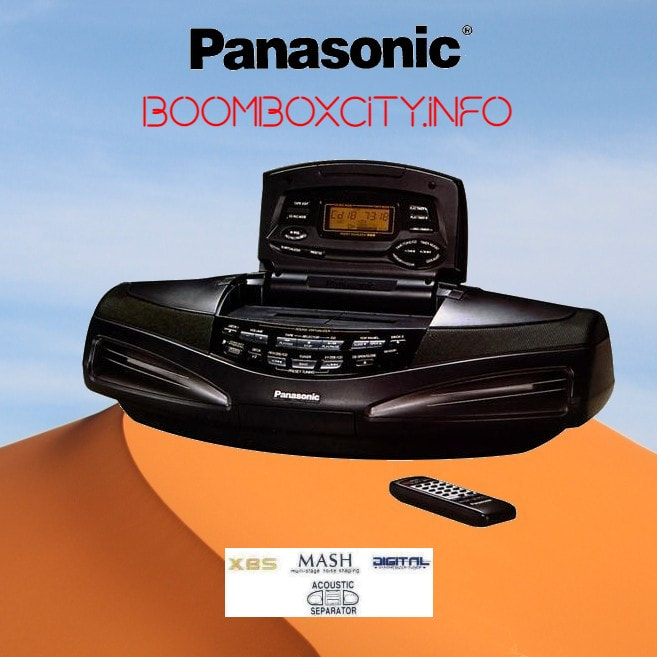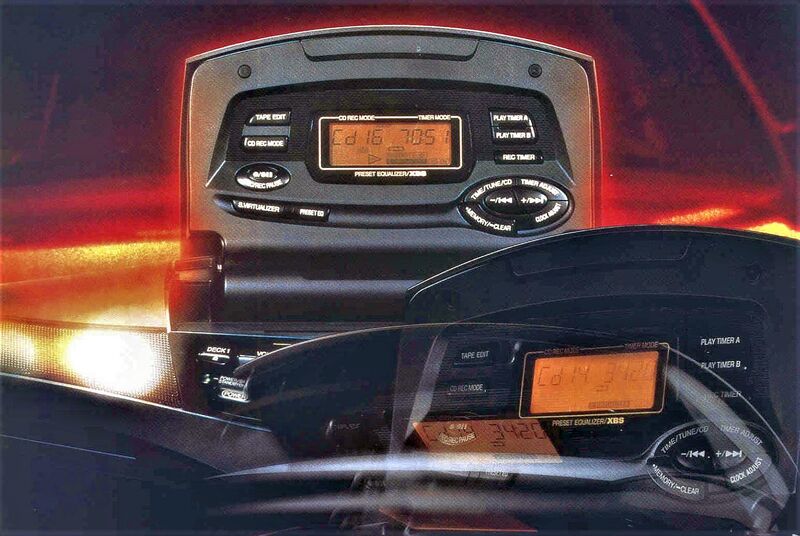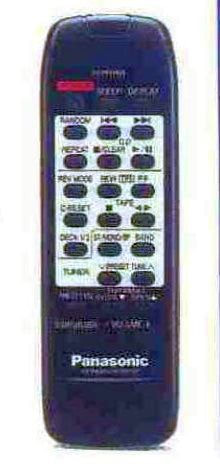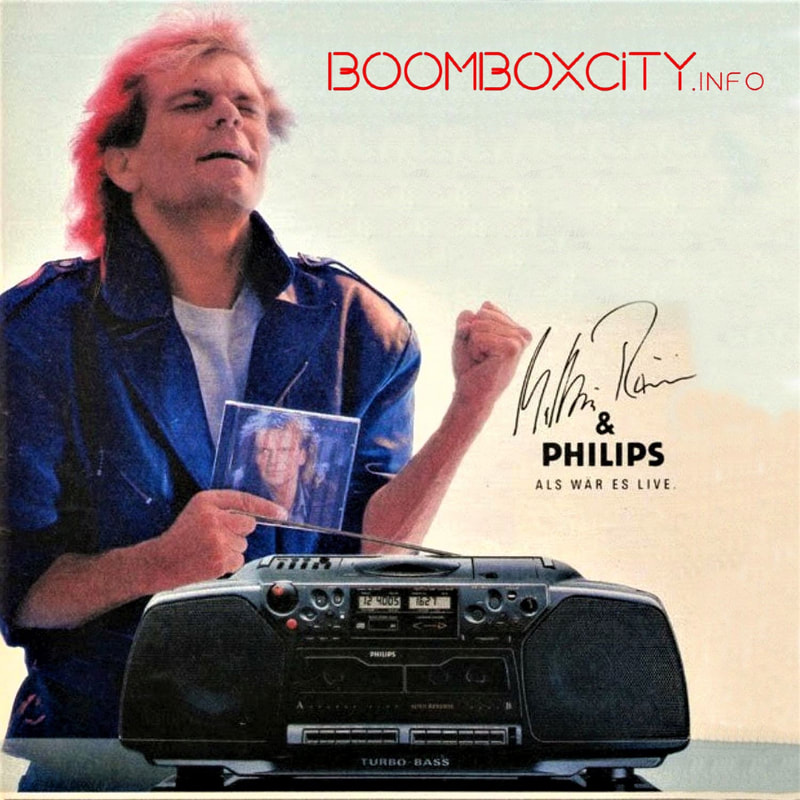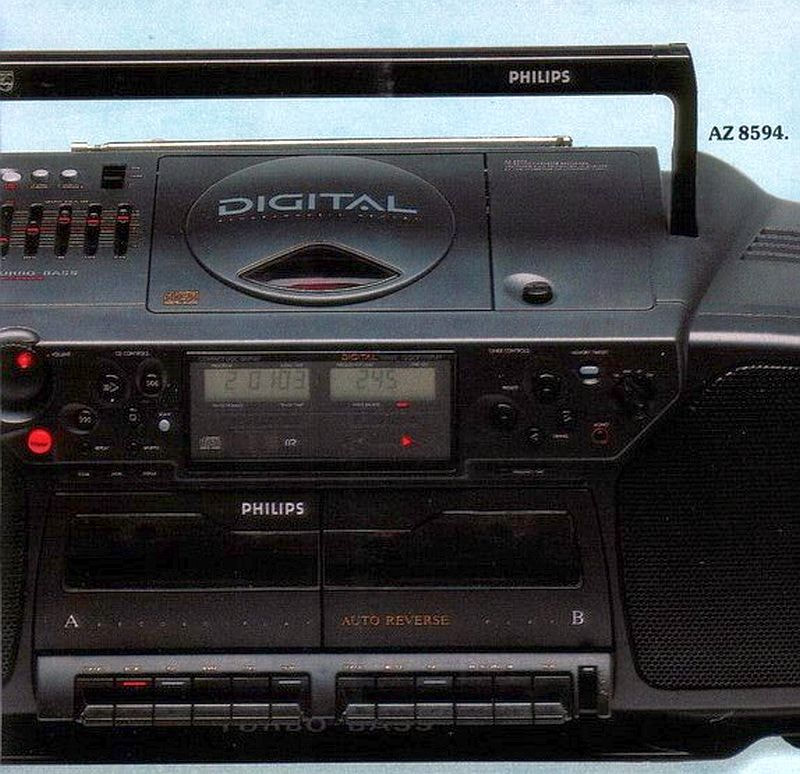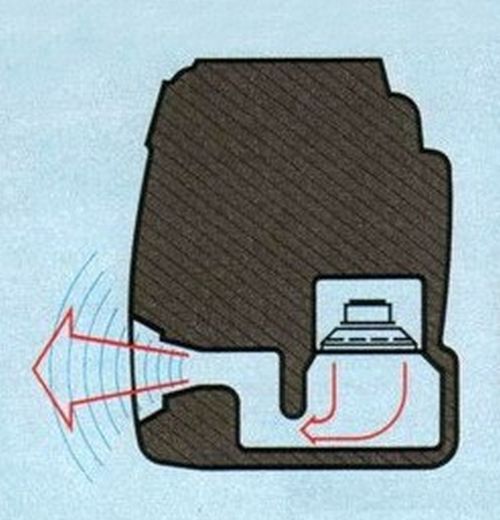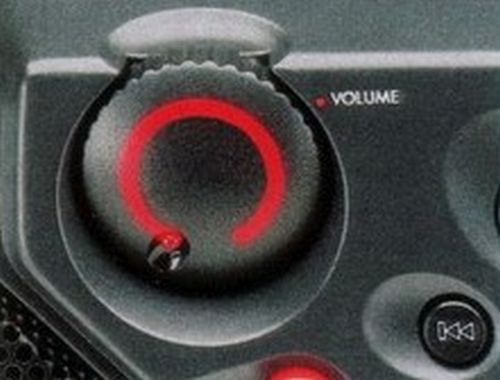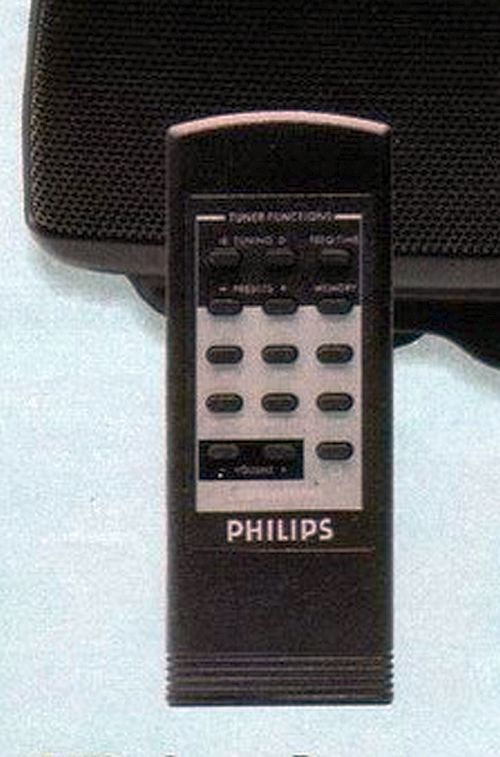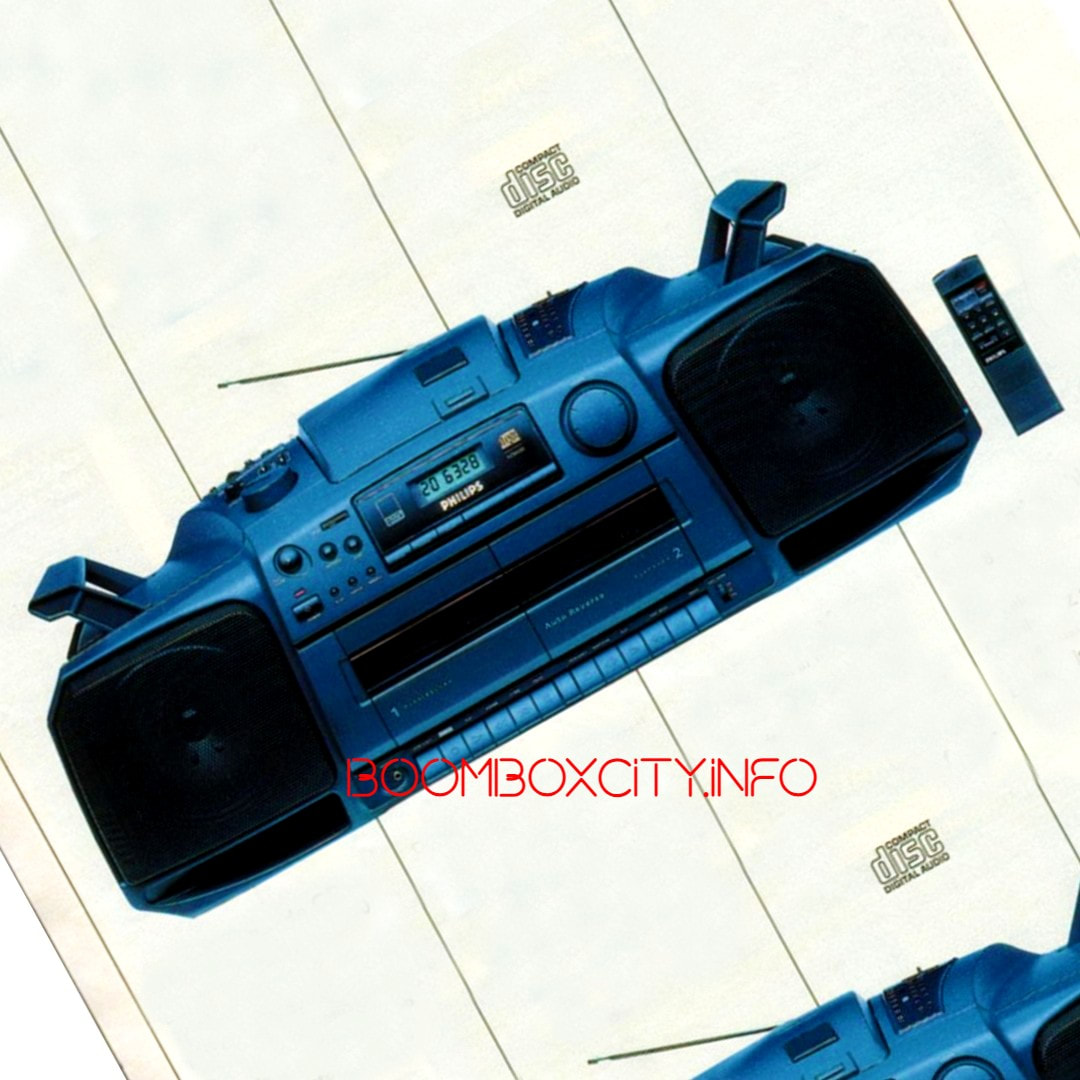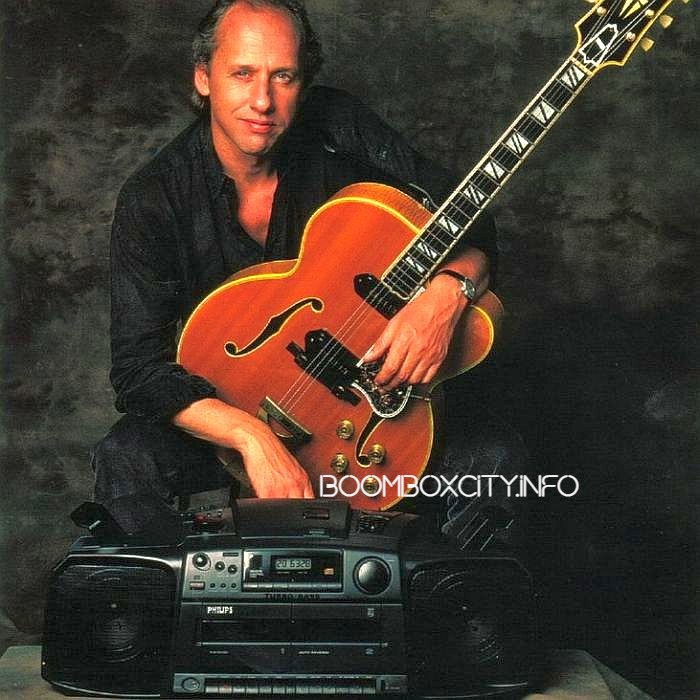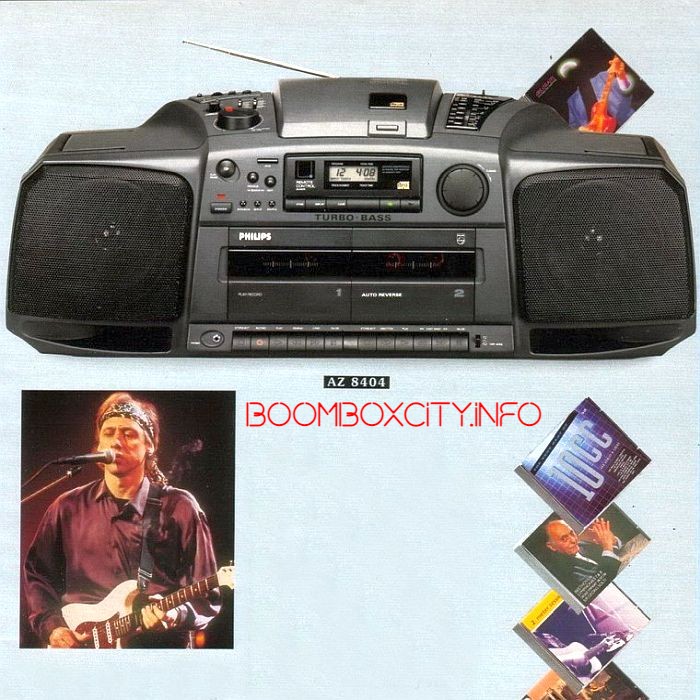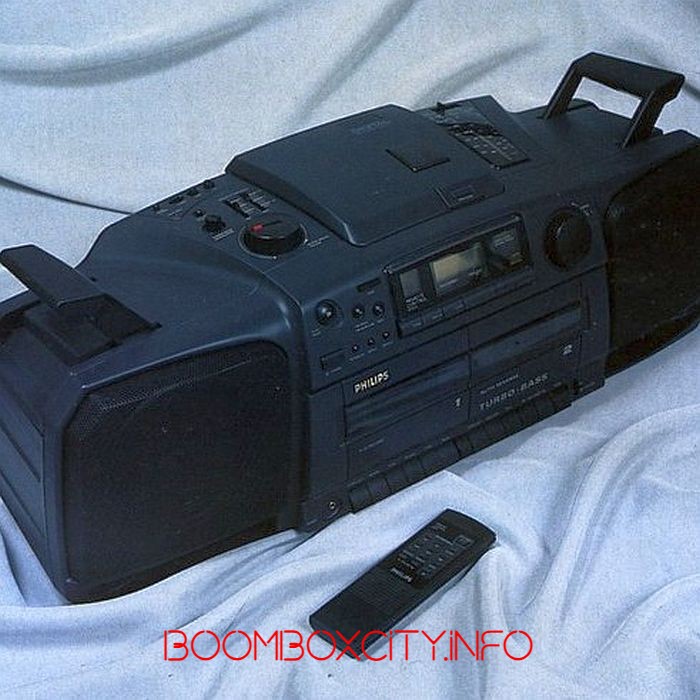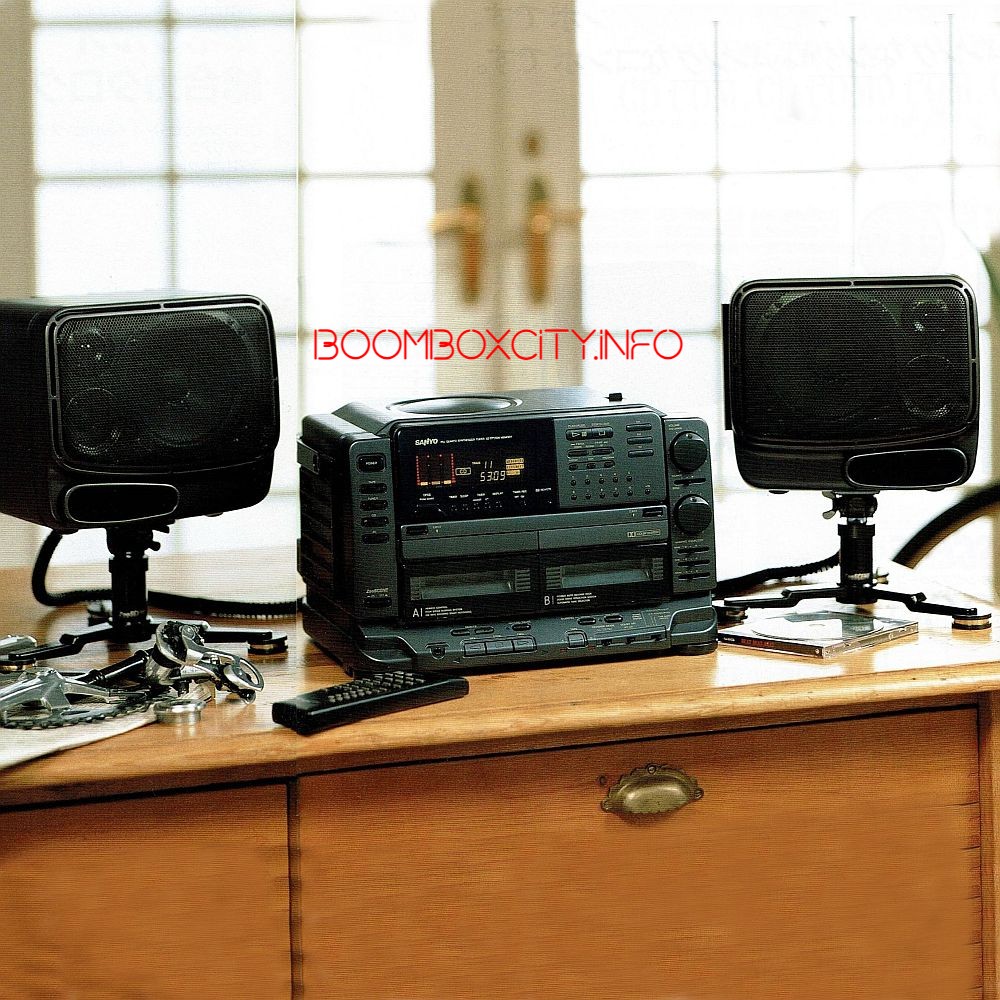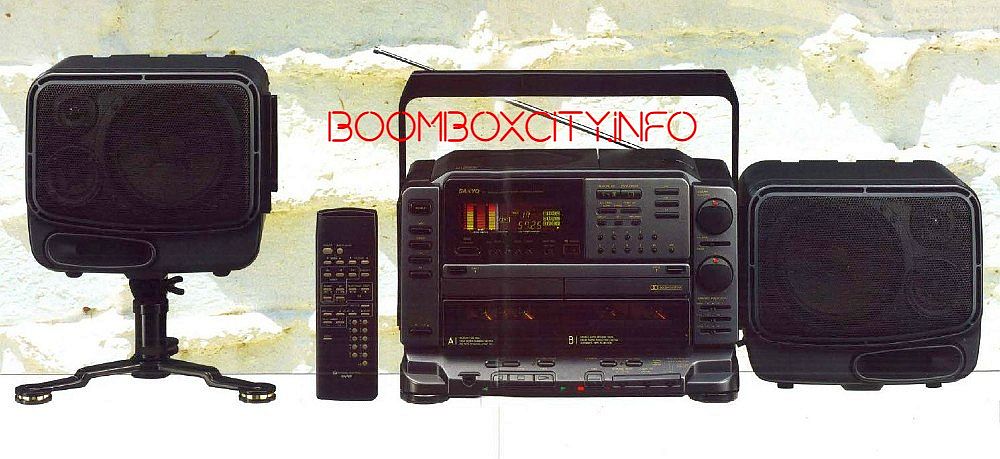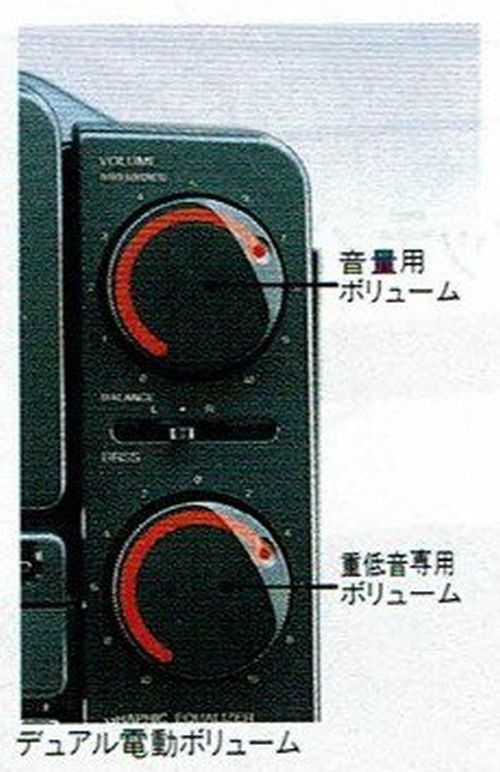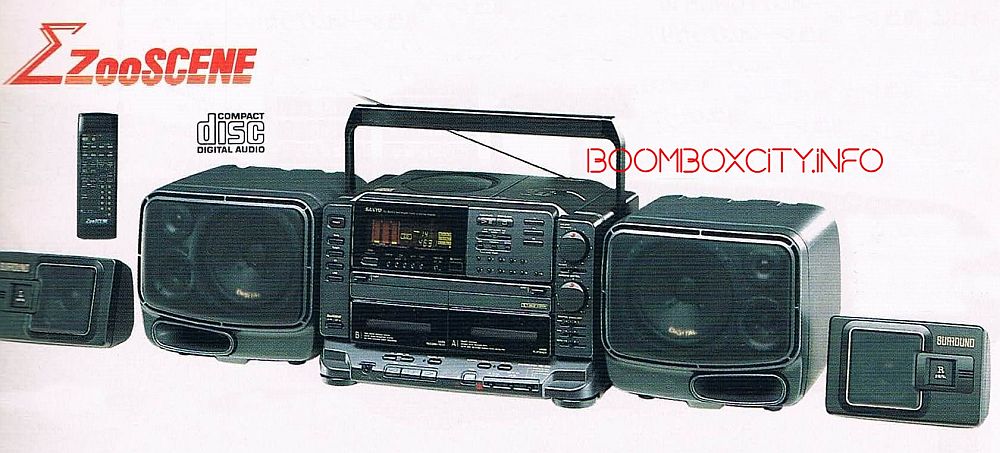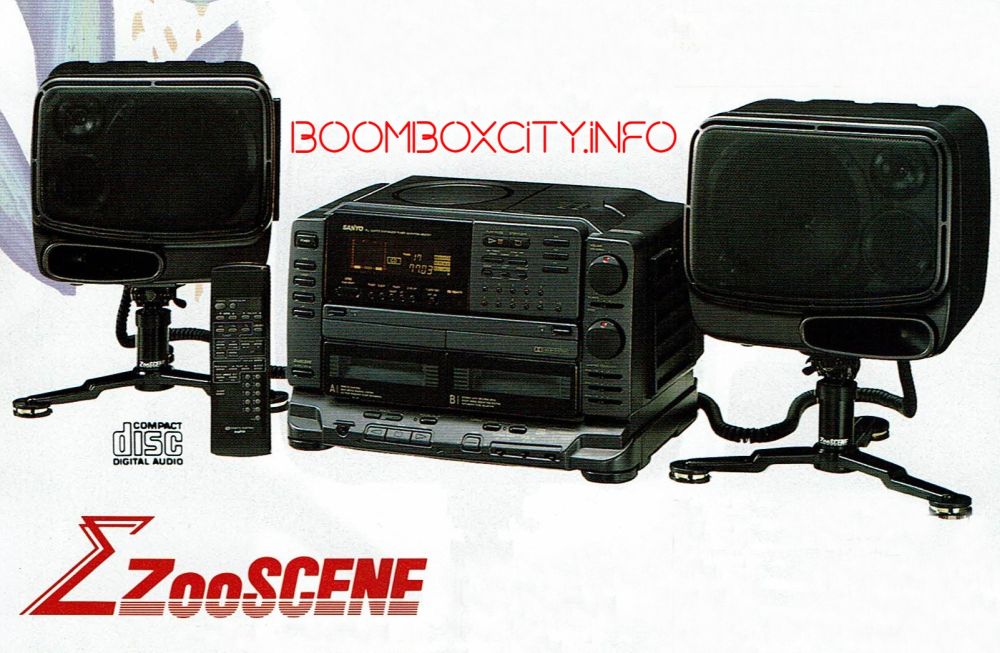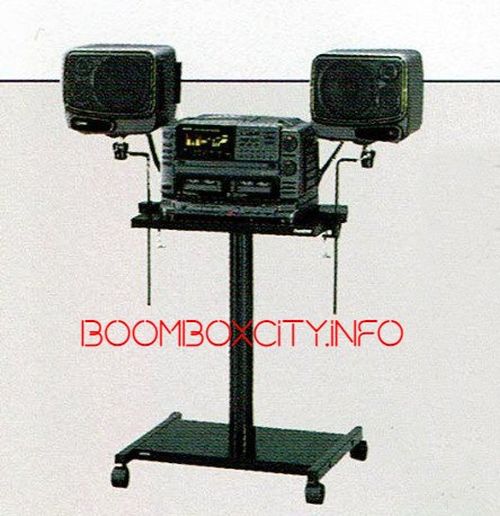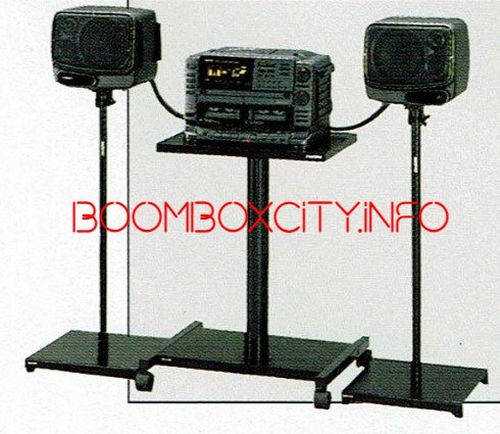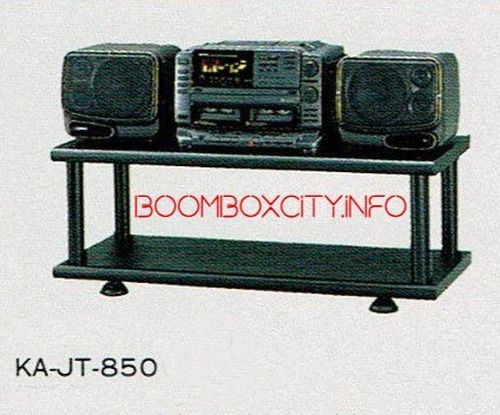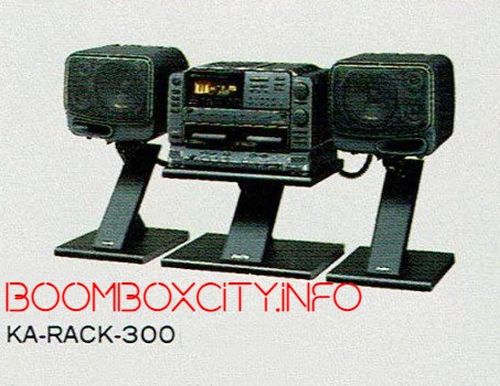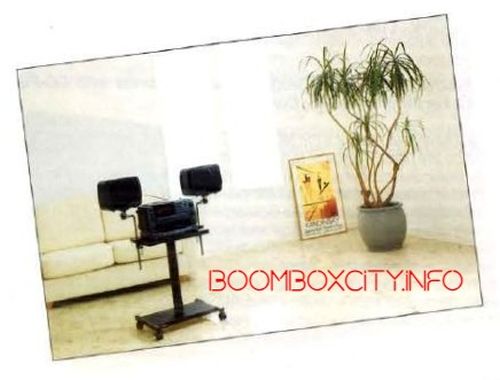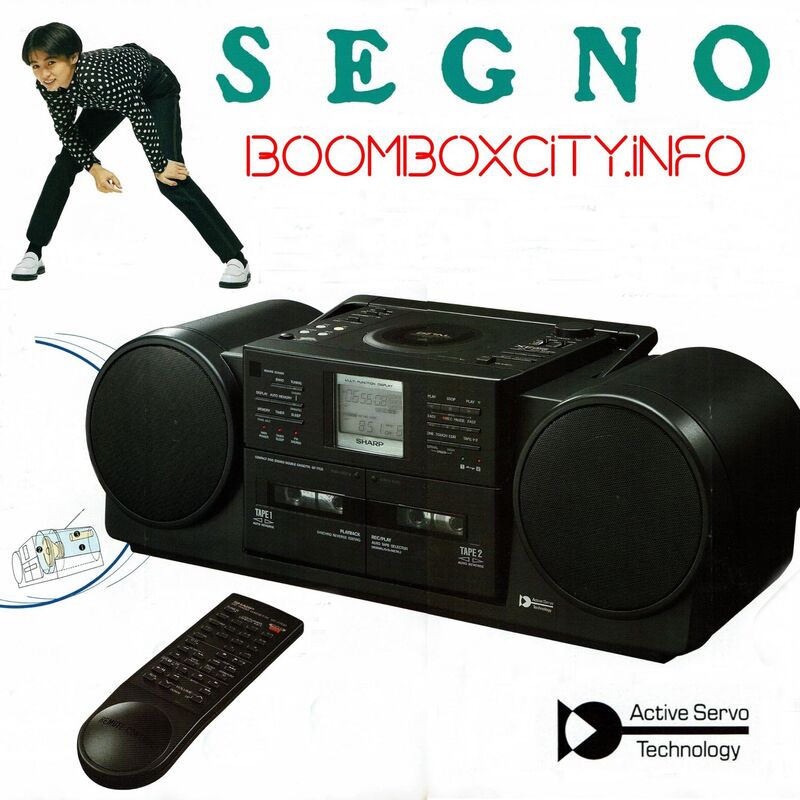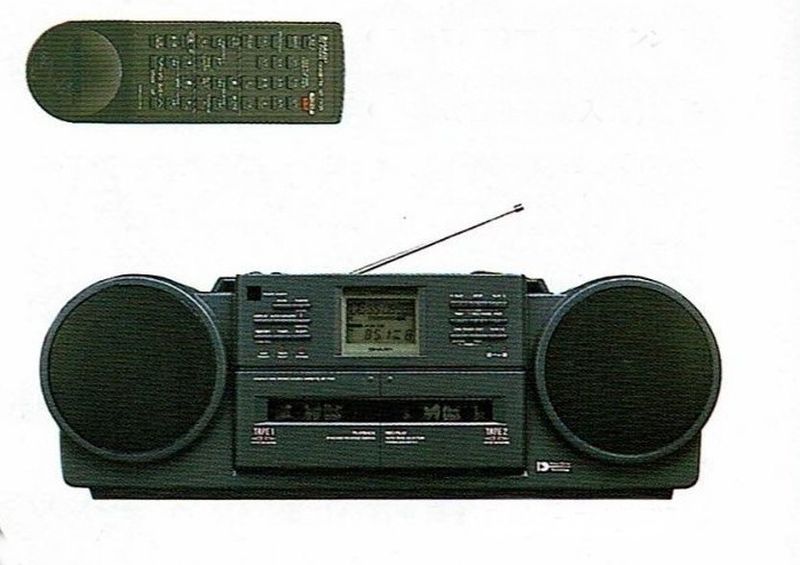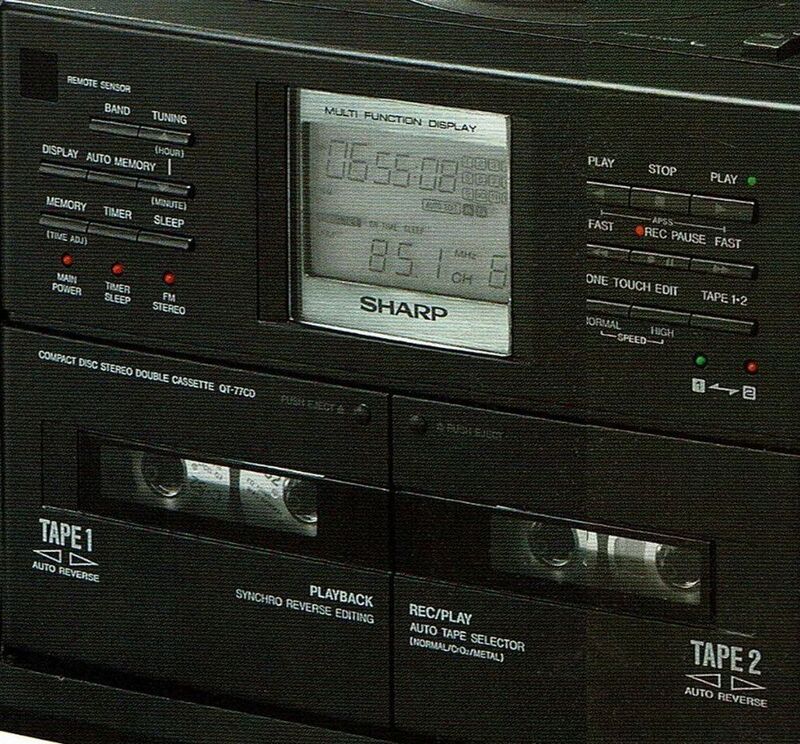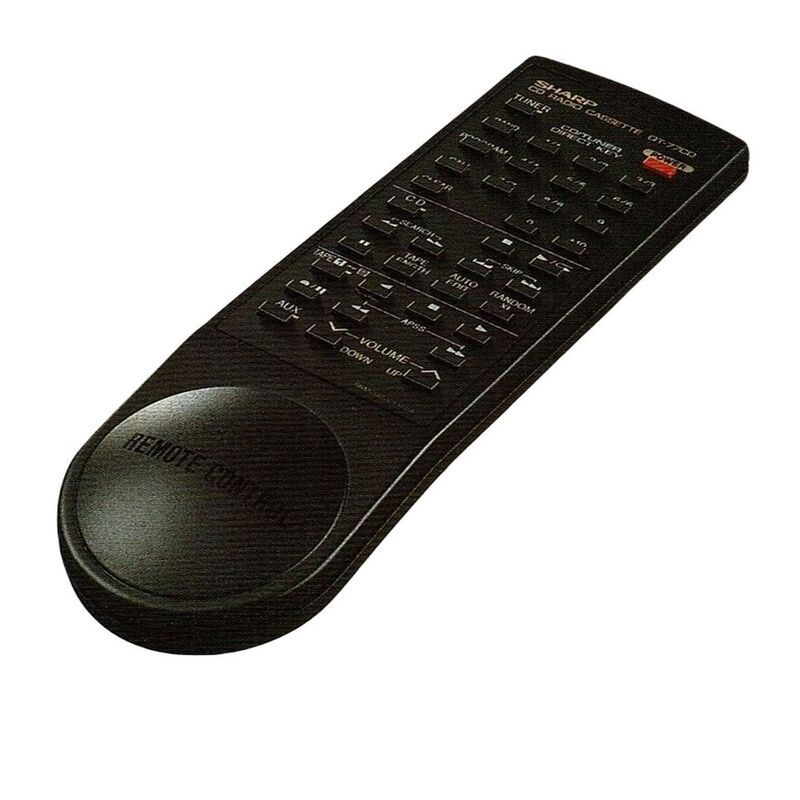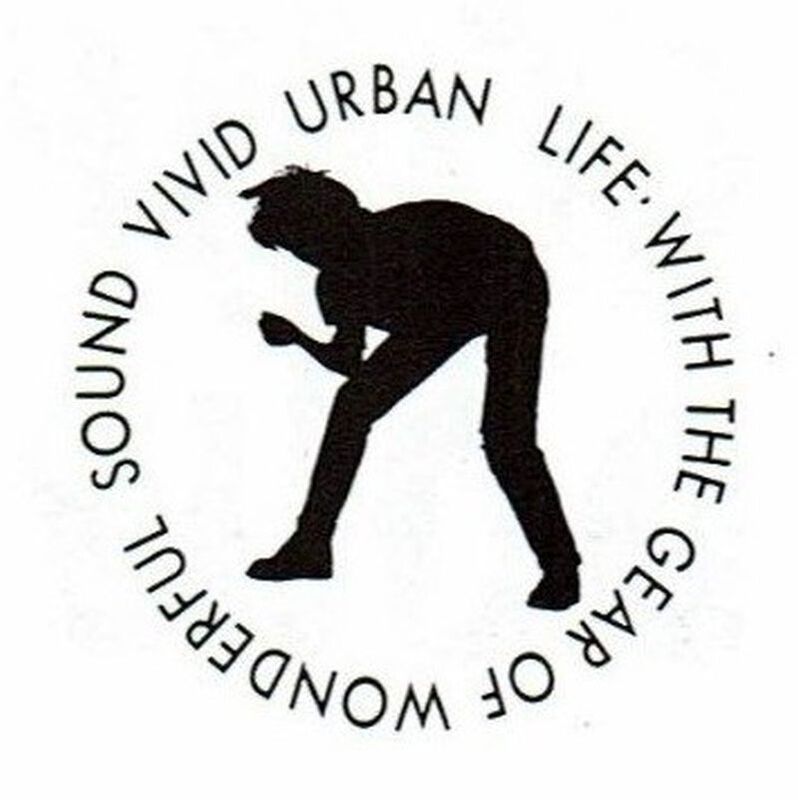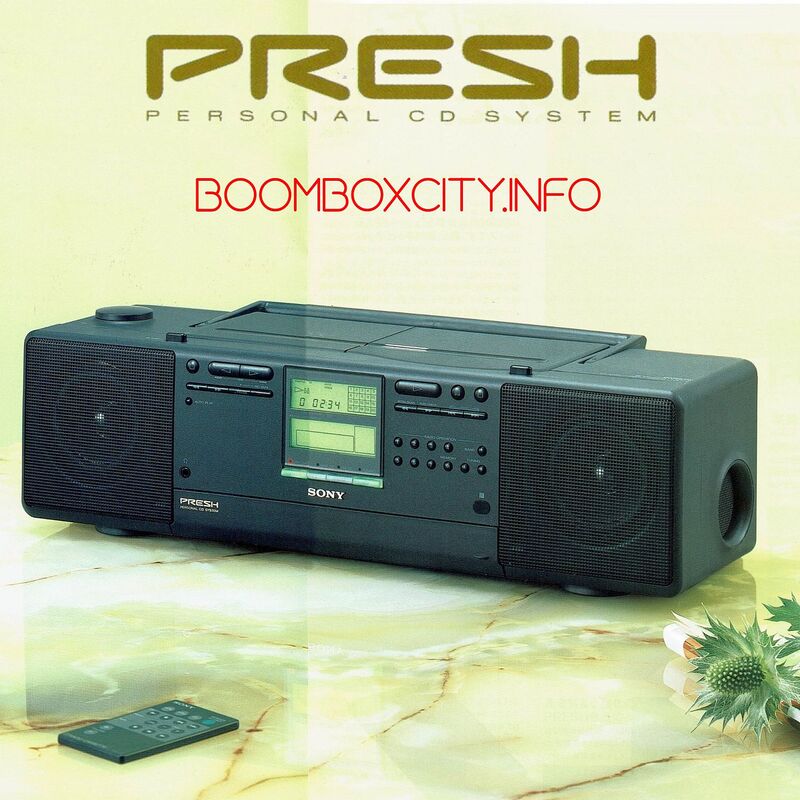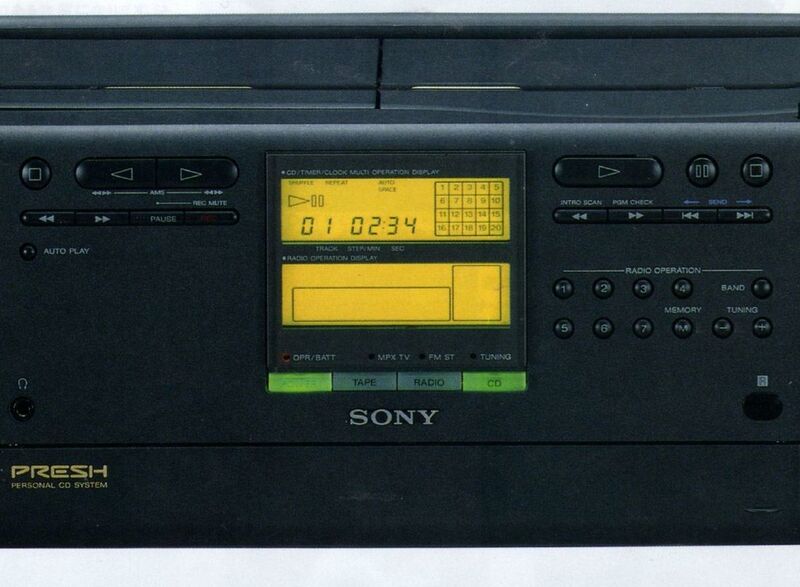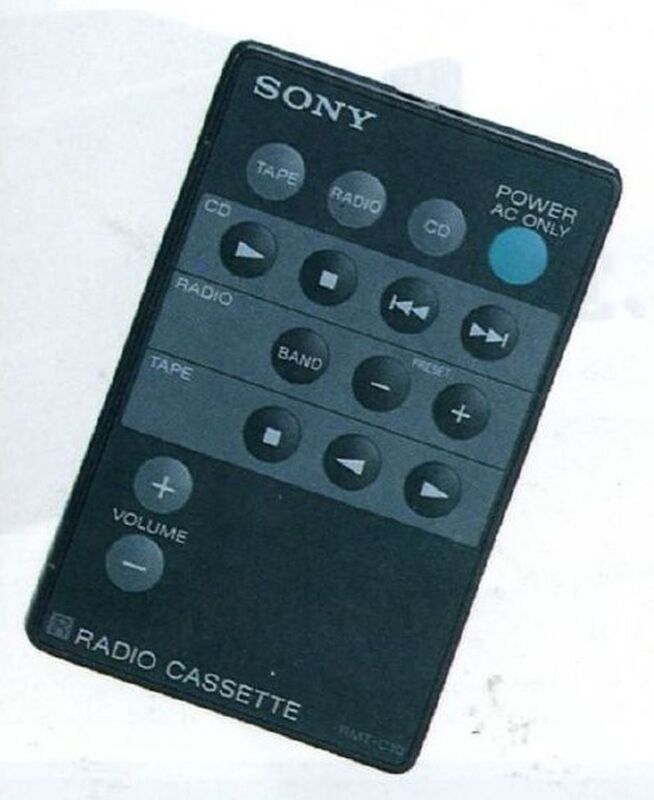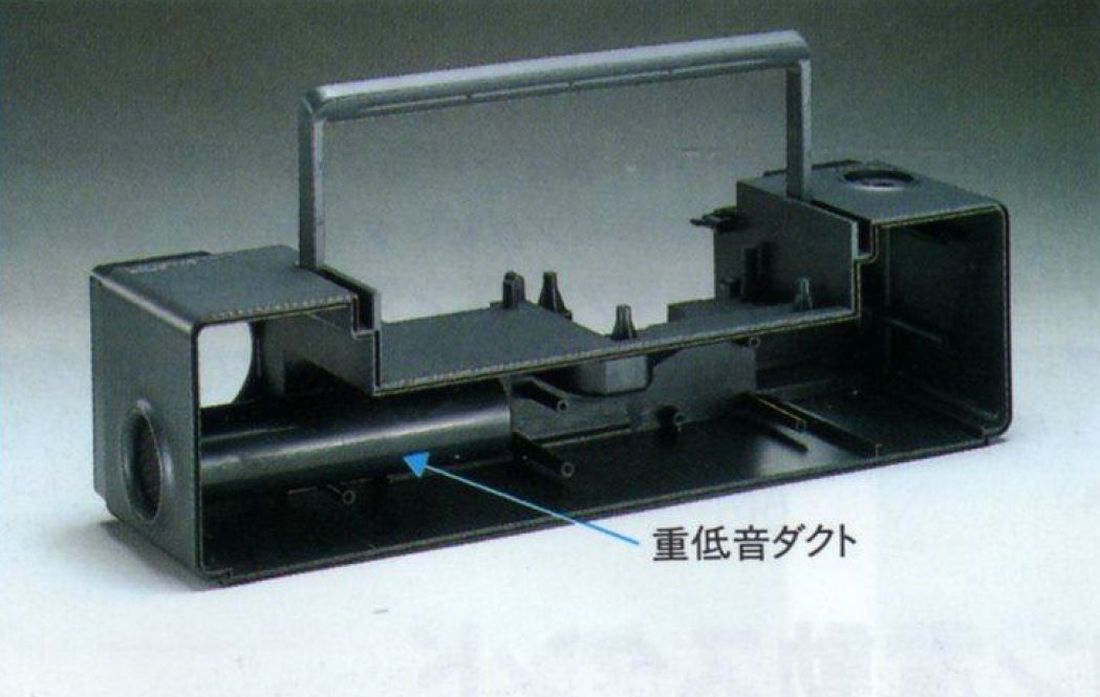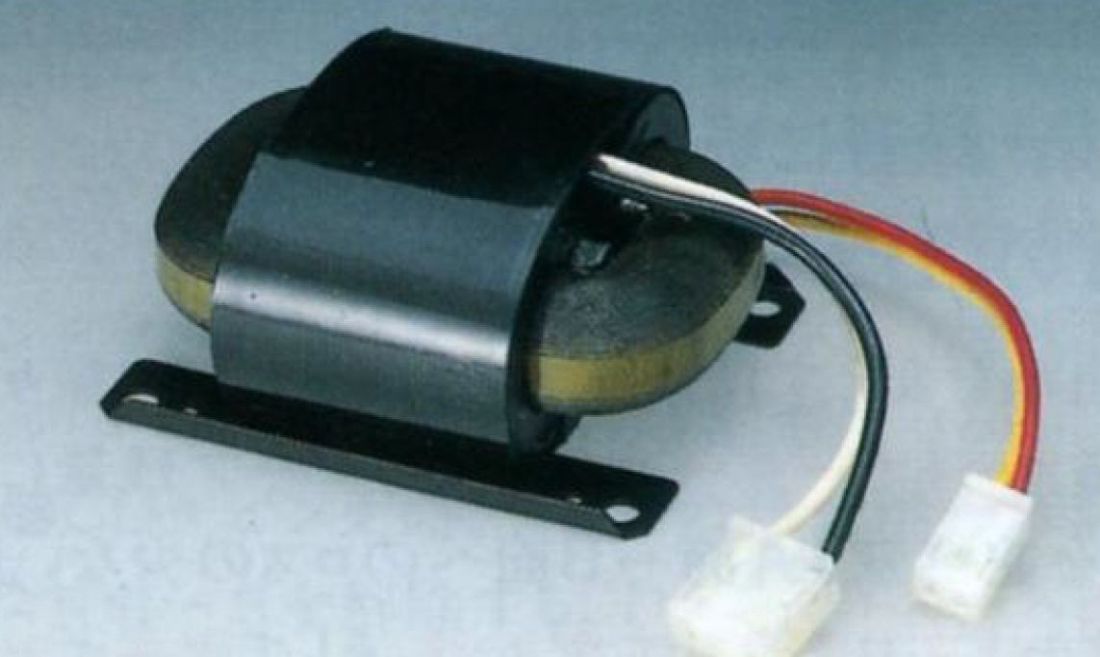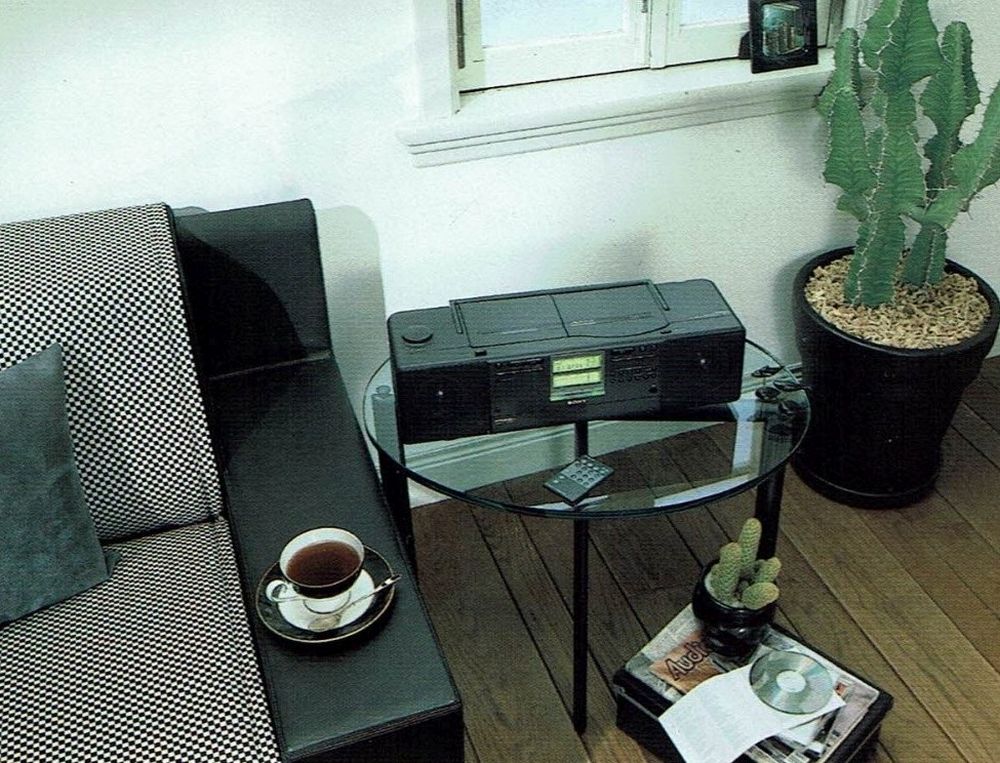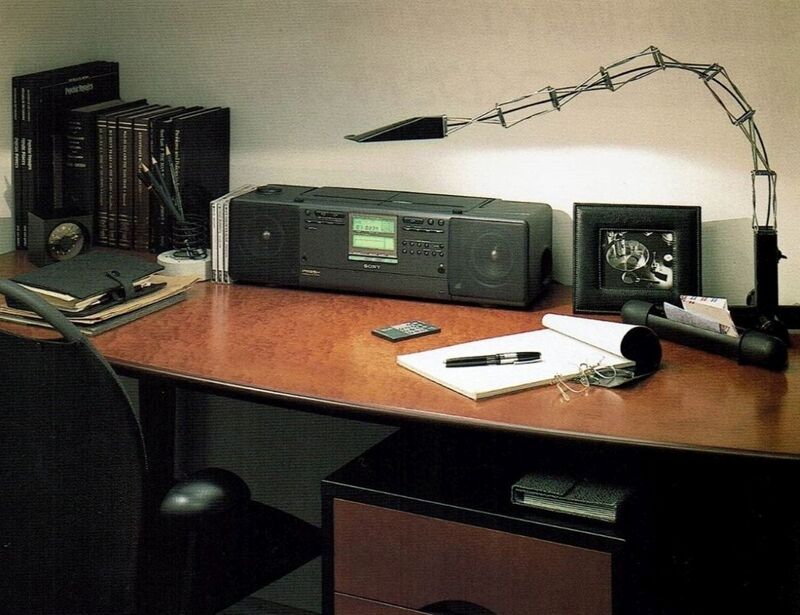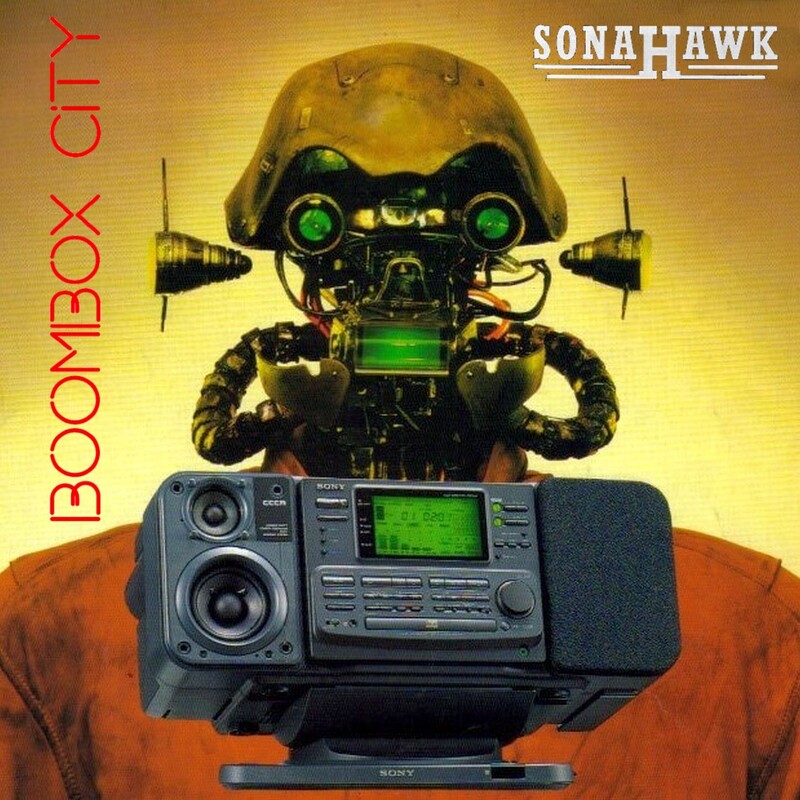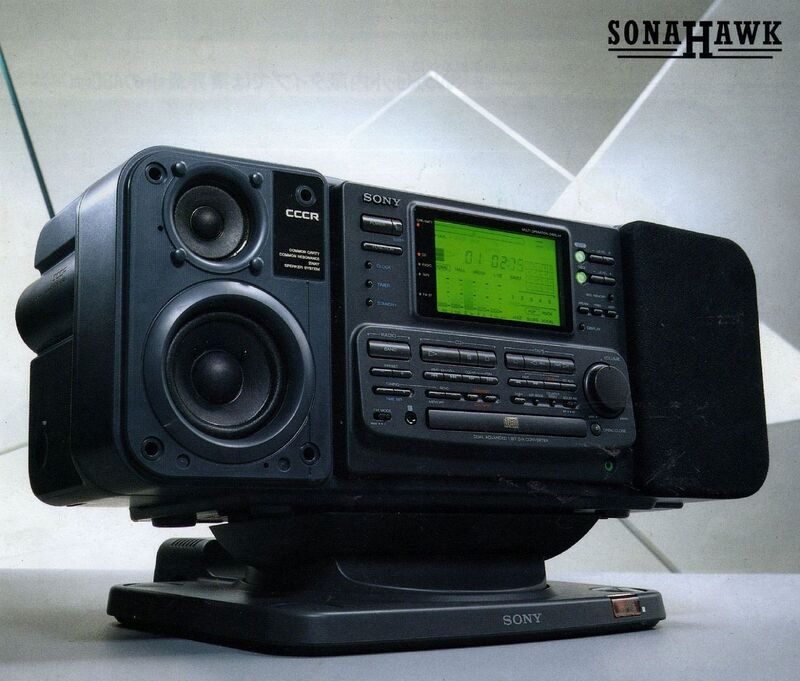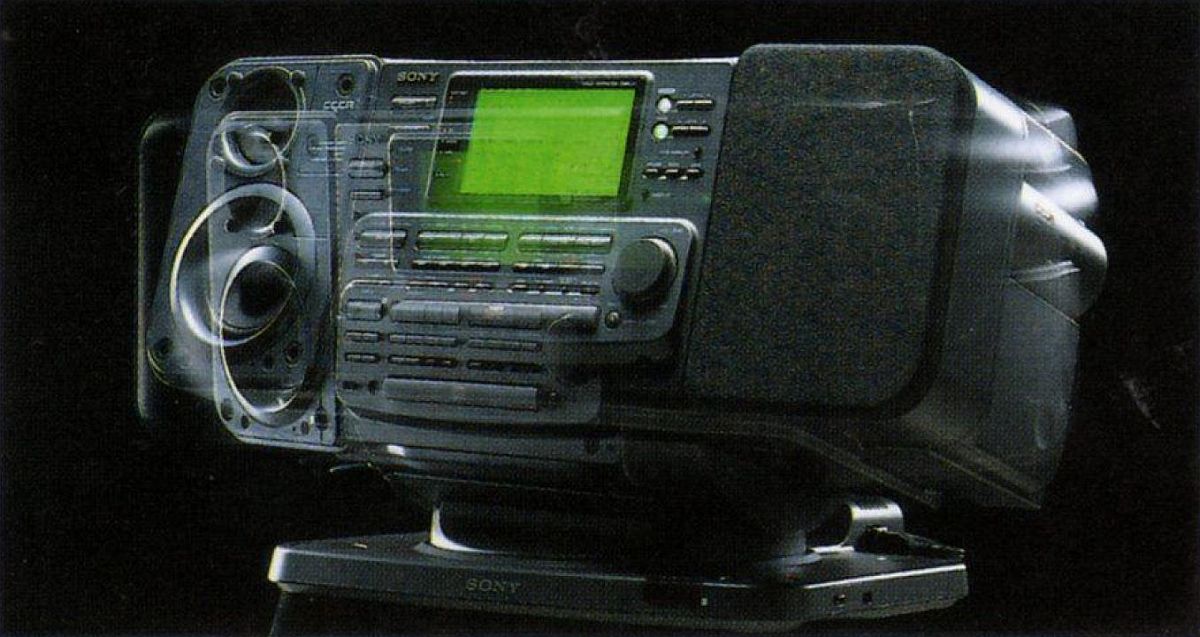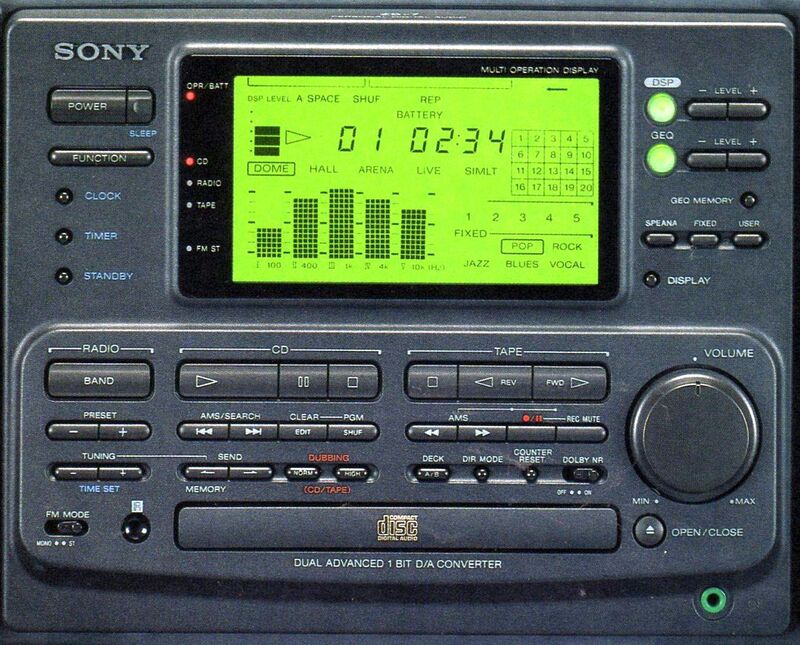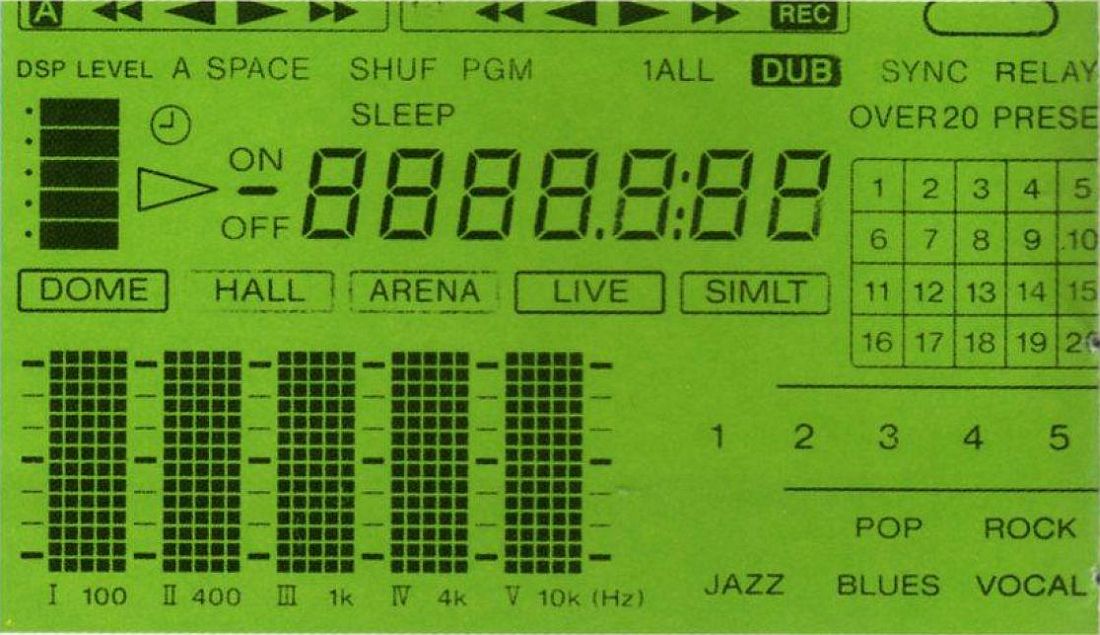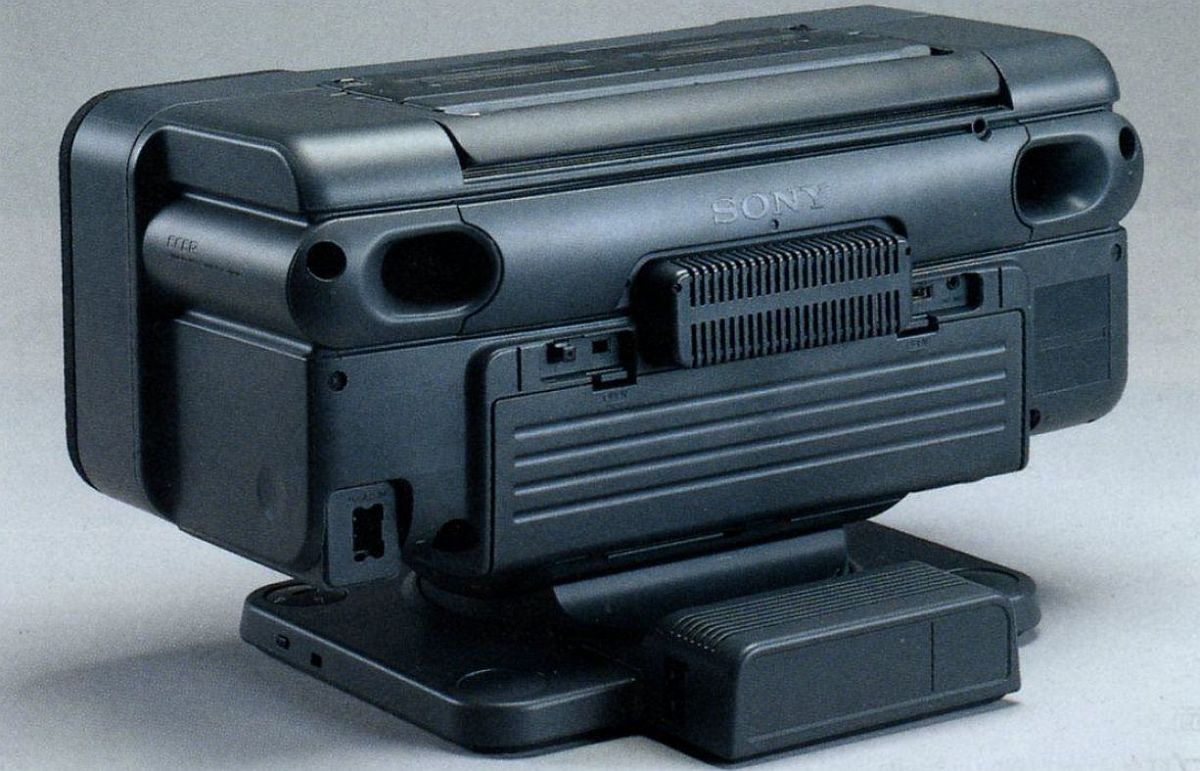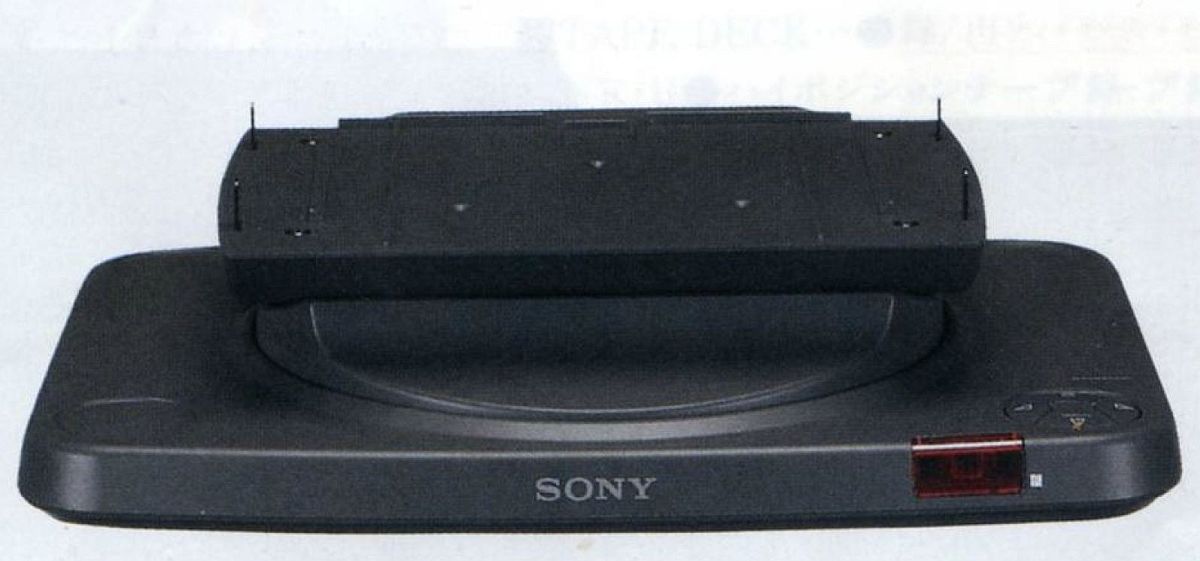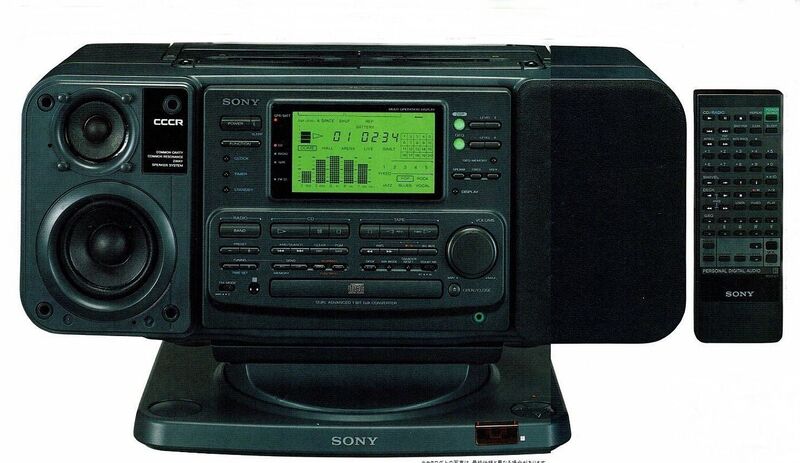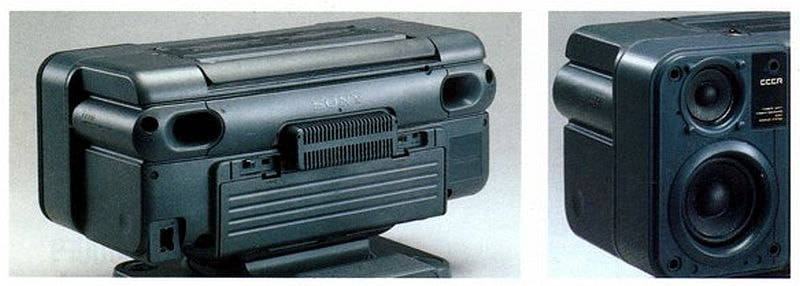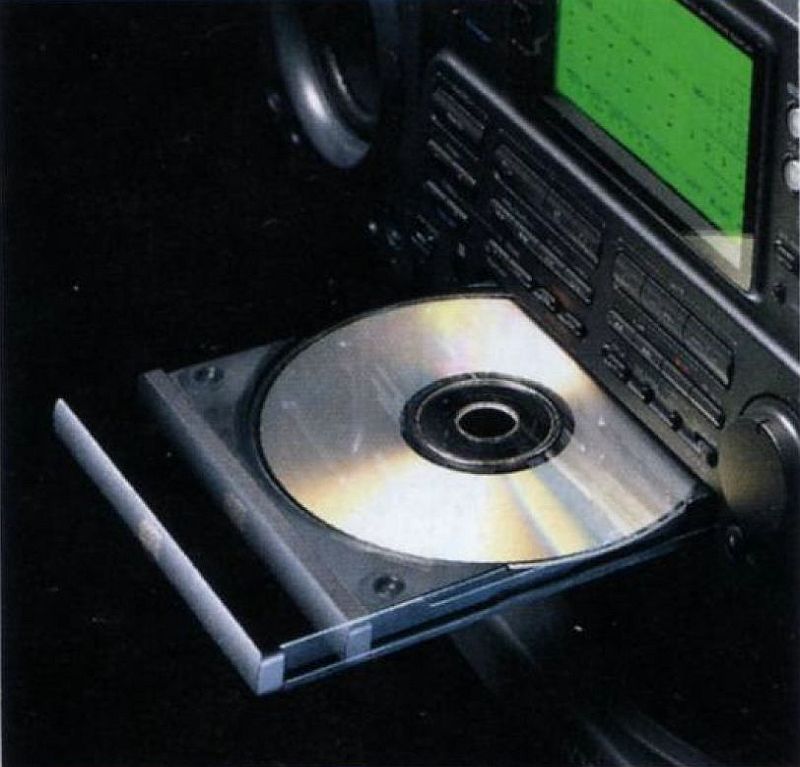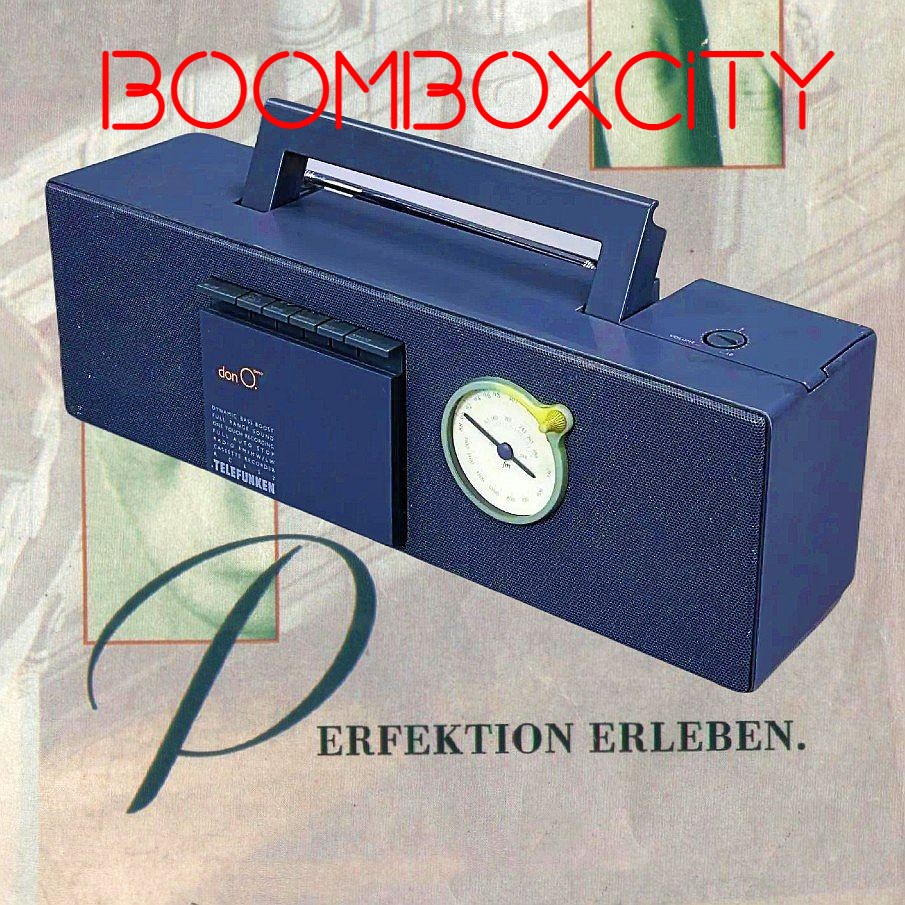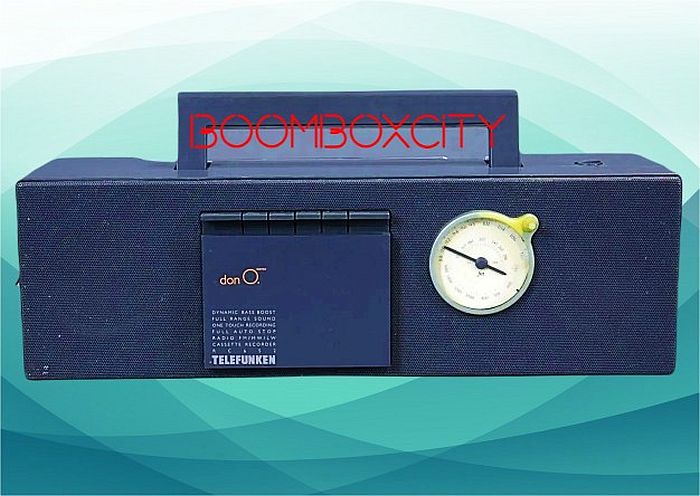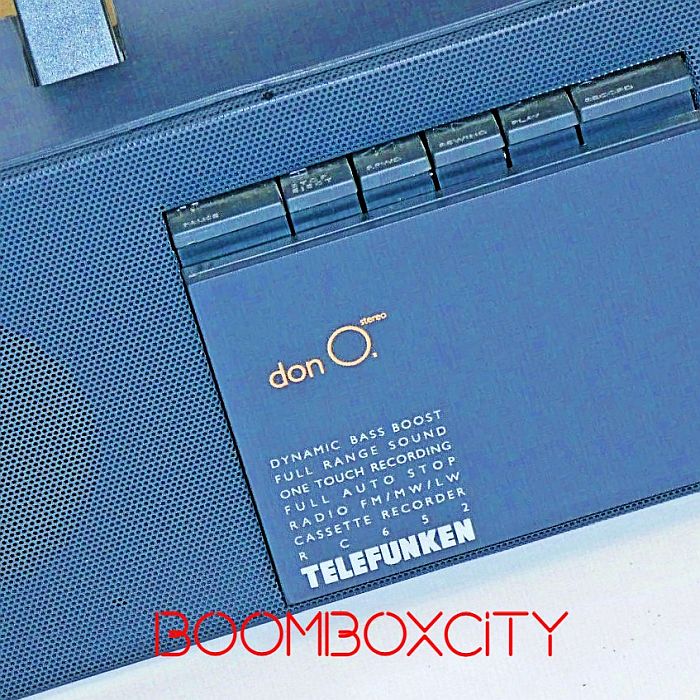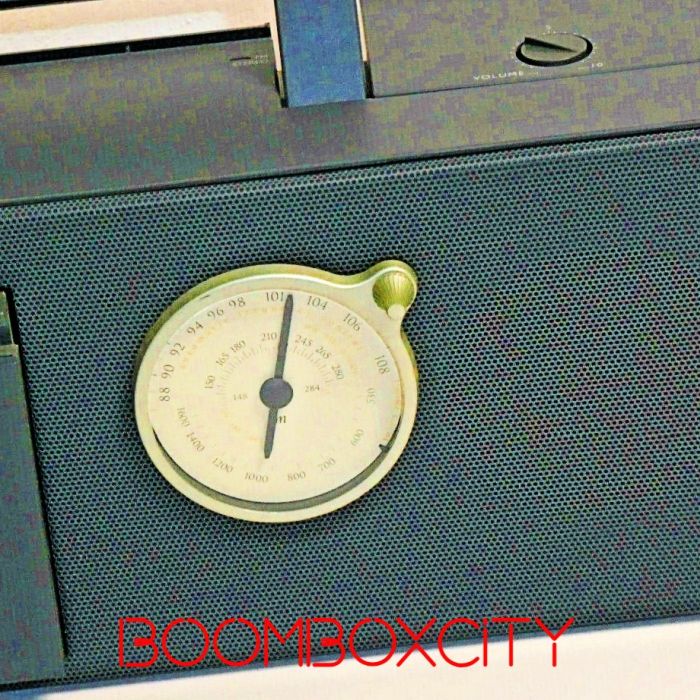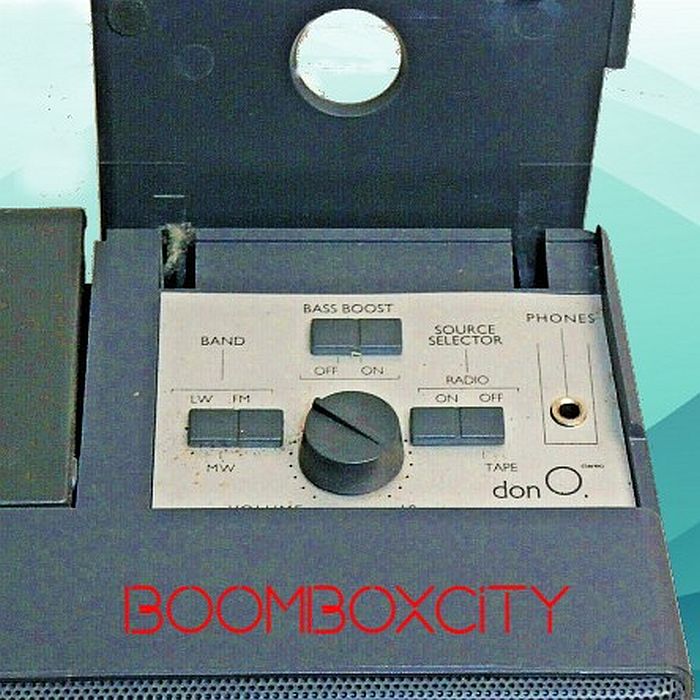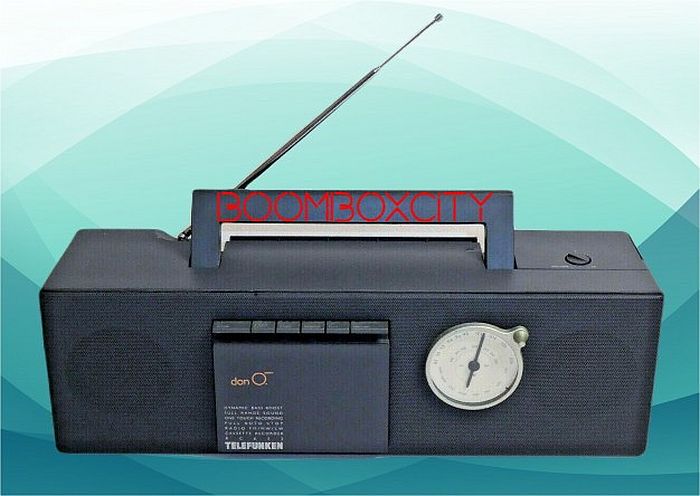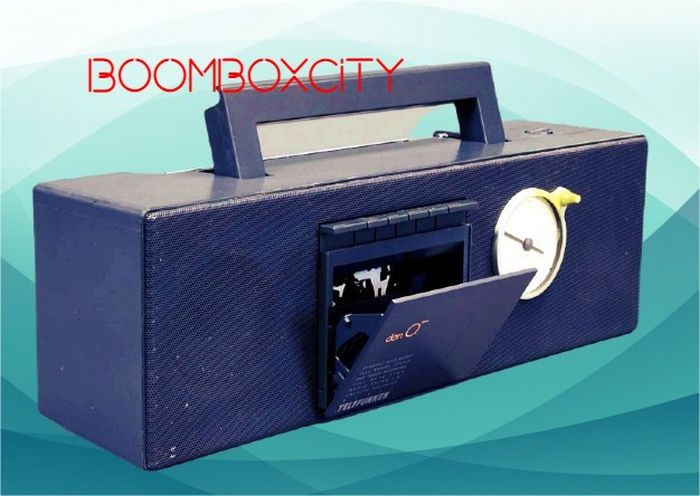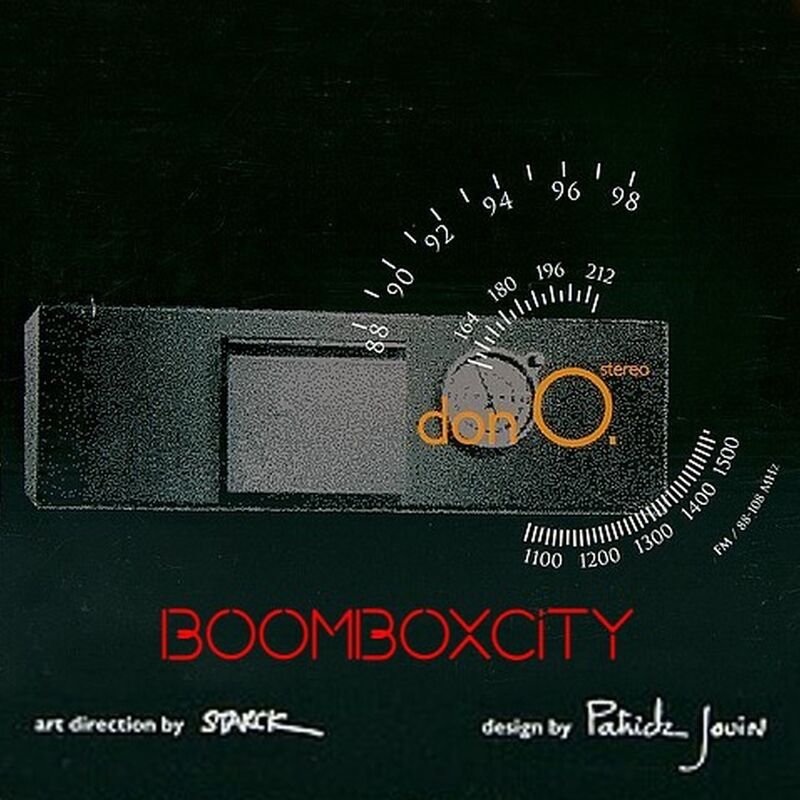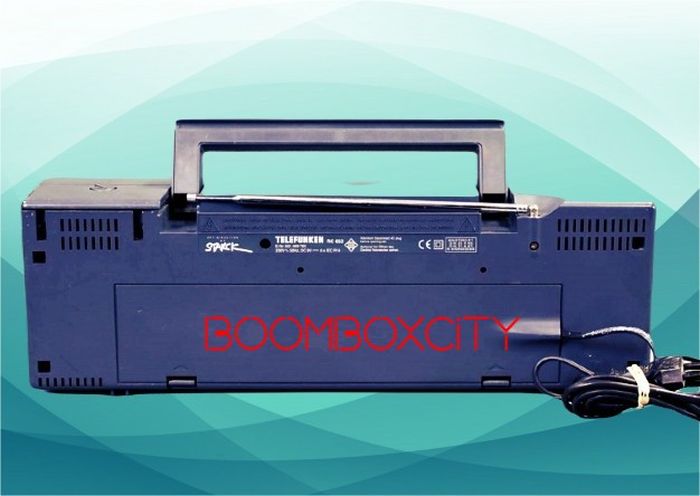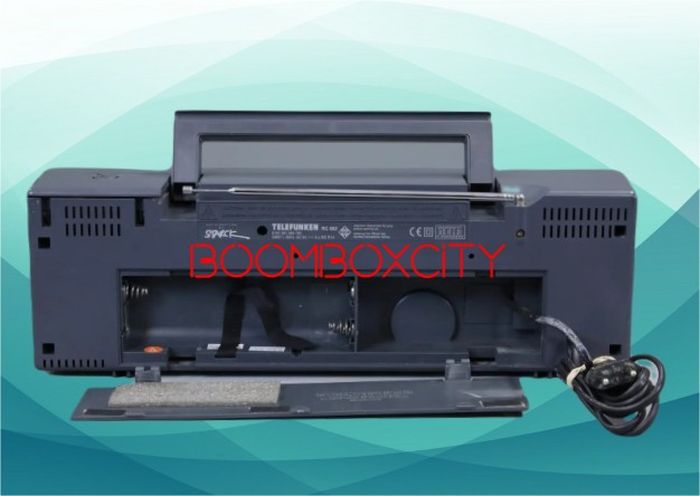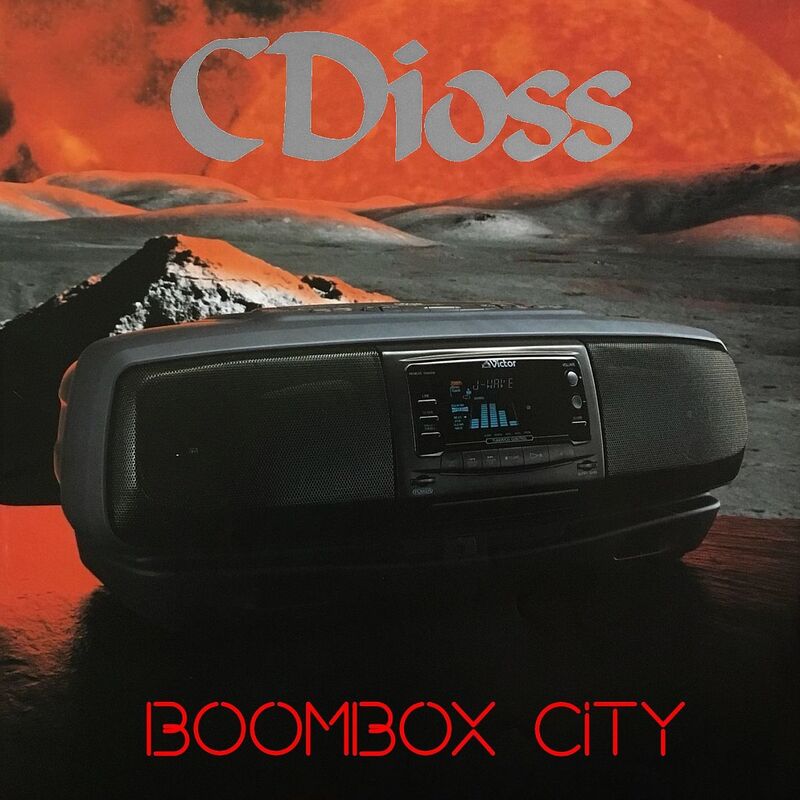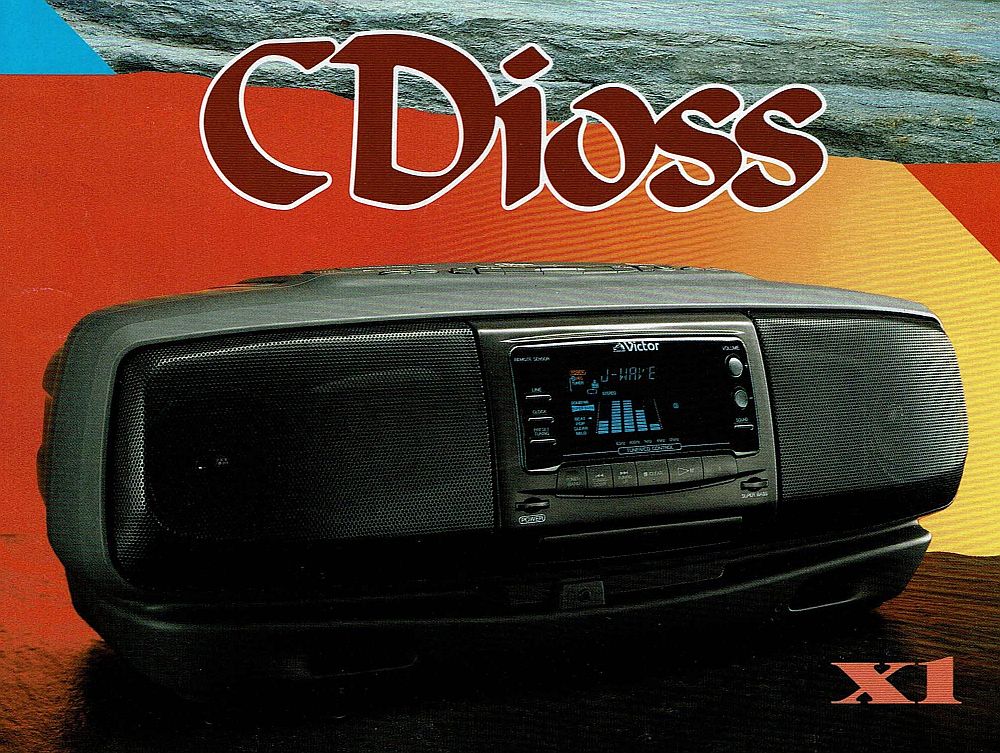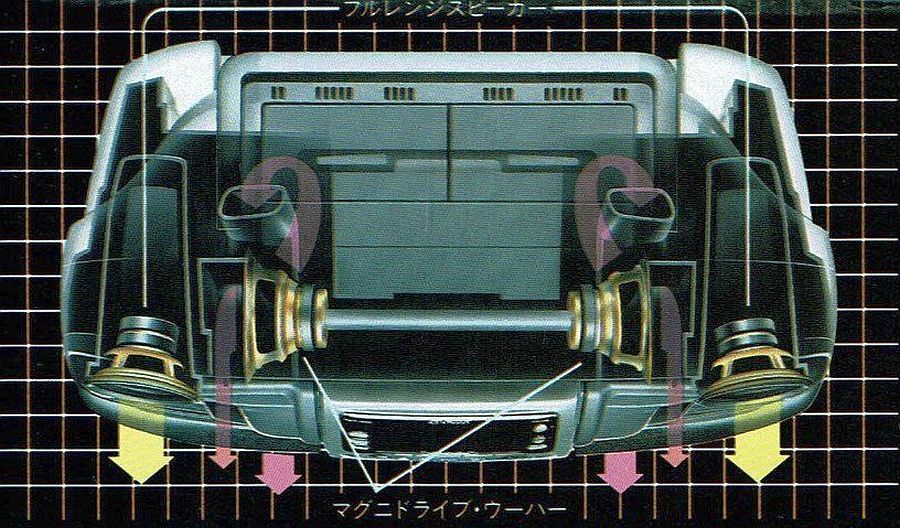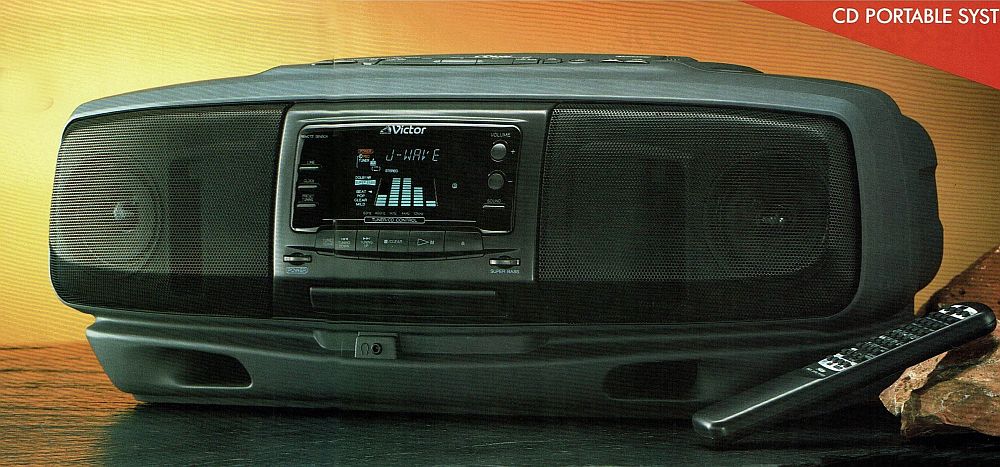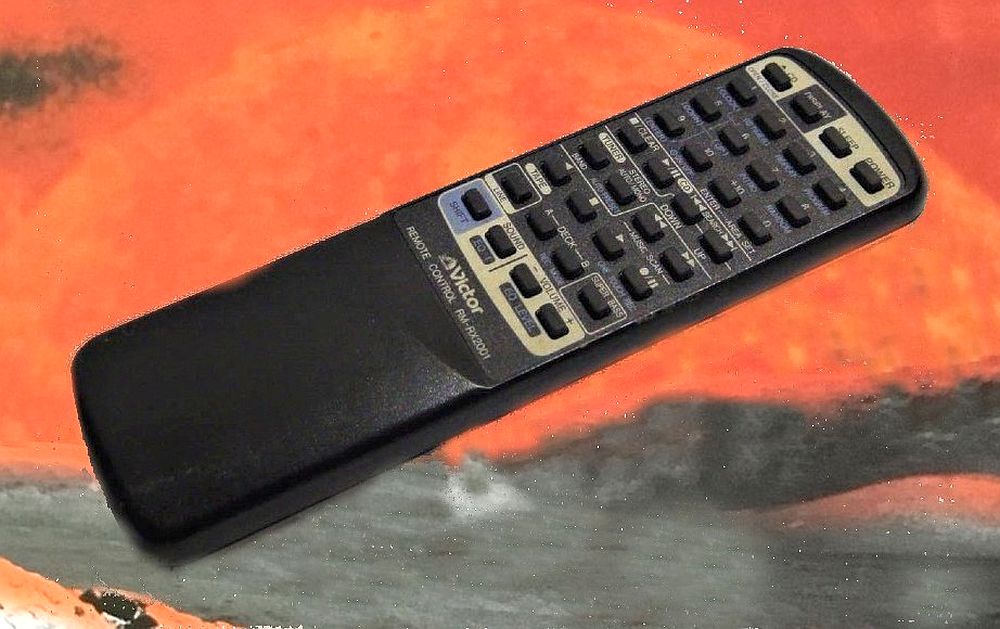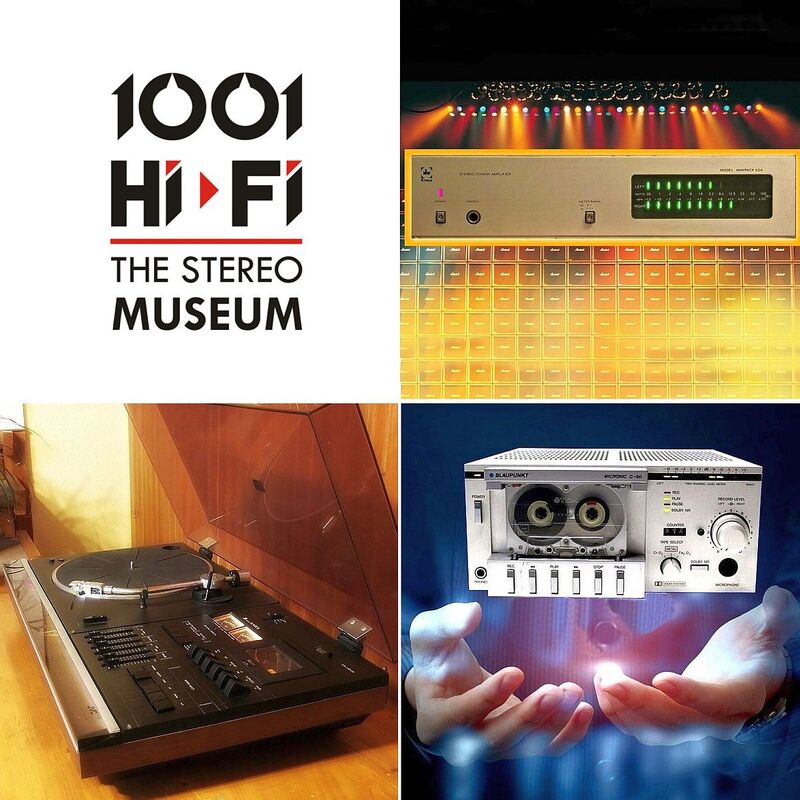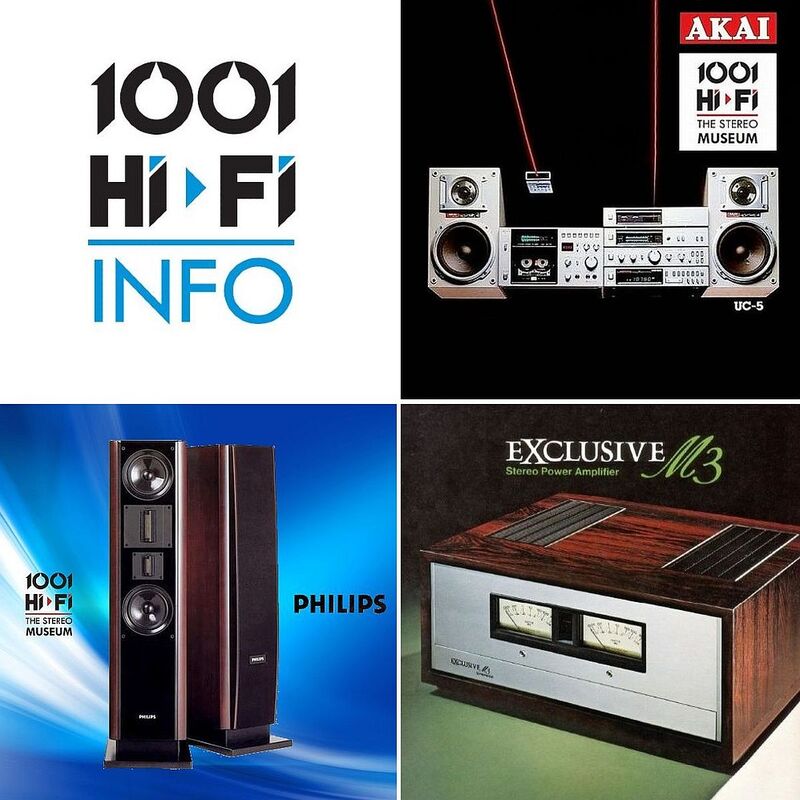AIWA CSD-XR90B (1990)
Introduced in 1990 the XR90 from Aiwa features a CD player, tuner and a double auto-reverse cassette recorder. The highlight of this portable, among others, is the use of the BBE sound processor. Generally, there is a slight difference between the sound played from speakers and the original sound. This is because during playback, variations in speaker vibration occur between the bass and treble ranges, and the balance of mid- and high-range sound components is disrupted, causing the sound to become distorted. The BBE system compensates for the two drawbacks during playback and provides powerful backup to ensure a smooth start-up of the sound. BBE was originally developed for professional use. Since Aiwa first adopted this for consumer use, its high performance has been widely demonstrated. Together with the 3D speaker system (120mm woofer + 2x80mm full range) and the 25W amplifier this boombox will produce a high-quality sound with deep bass. The top loading CD player features all the usual functions that are displayed on the front panel on a dedicated CD only display. A wide range of editing functions are available when making copies to a cassette, double speed copy of CD to cassette included. On the center control panel, we will find all major controls for smart operation. The center of this control panel is dominated by three individual backlit displays, one for the CD player, one for the tuner and a large display for amplifier functions. The so-called AI volume control has various extra functions: Memory volume - When the power is turned on, it is automatically set at the volume before turning it off. Standby volume - Even if you turn off the power using the remote control, you can adjust the volume before turning it on again. Wake-up volume - Sleep function allows you to freely set the alarm playback volume. Automute volume - When dubbing at double speed, reduce the volume to a level that can be monitored. A tuner with great features is also part of this sophisticated model. Since it is a TV audio multiplex system, you can also enjoy stereo broadcasts and bilingual broadcasts. The XR90 features a total of 24 station presets including TV and AM/FM. The cassette section has a logic controlled auto-reverse unit for playback and a logic controlled auto-reverse unit for recording and playback (with Metal tape compatibility and Dolby noise reduction). Various data from the cassette section can be displayed on the main display such as: tape size, linear time counter, track selection for music skip and more. A 40-key full remote control is also included for easy operation from anywhere. Aiwa calls the shape of the unit a "three-dimensional aerodynamic form" that was obtained using FRESDAM, a free-form design and processing system developed by Sony Corporation's Research Institute that allows for the rich expression of free-form curved surfaces like those seen on the XR90. Size: 720x247x304 mm | Weight: 10kg | Power: mains, batteries.
AIWA CSD-EX5 STRASSER (1993)
The Aiwa CSD-EX5 is part of an extensive range of portables introduced in 1993. It has very simple and elegant lines featuring a hidden autoreverse cassette recorder on the top and a drawer type cd player at the front. The whole system is remote controllable via a removable hand-held unit that can be stored right above the cd tray. The radio section has 24 station presets, the cd player is a 20-track programmable unit with CD to tape synchro copy function and there is also an illuminated front LCD display with clock and timer function. The amplifier section is 60 W (PMPO) which actually means 7W/ch Sinus power in reality. It was available in black and titanium finish and was part of the so called STRASSER series in Japan. Dimensions: 460x148x202 mm | Weight: 4,2 kg | Operation: 12V external, 8xUM2 batteries.
KENWOOD MDX-E7 Limited (1997)
The Kenwood RAMPAGE MDX-E7 Limited is the second generation of the original MDX-E7 featuring an improved woofer with larger magnet. This is a 3 CD changer, minidisc recorder and radio portable unit. The MD section has 20bit D/A and A/D converter and a 20bit D/A converter CD player. The MD recorder is using ATRAC audio data compression and it can be used with a keyboard cyber titler (CT-G90). The FM stereo radio section has name input selection and auto preset tuning. The amplifier section consists of a 2x10 W transistor power modul driving a 2-way speaker system with alpha-duct (10 cm woofer and 40 mm tweeter). At the back of the unit, we can find an AUX in/out and a subwoofer pre-out. The whole system can be remote controlled with the Kenwood RC-MDX07 infrared hand-held unit. Dimensions: 570x219x296 mm | Weight: 8 kg | Operation: mains
Panasonic RX-DS660 (1990)
Panasonic Platinum. Precision audio components matched so perfectly it's no mere portable stereo. If you set out to find your dream stereo system, it would probably have a programmable CD player with 16-bit 4x oversampling. A digital FM/AM tuner. A full-function cassette deck, 4-way air suspension speakers, and an XBS extra bass system for powerful sound. This is how a Panasonic advert from 1990 introduced the RX-DS660. In addition, the RX-DS660 has a 31-key remote control too. This Platinum Collection portable stereo does things you'd never dream of. By pushing a few buttons on its handy remote, you can program the CD to play up to 36 selections in any order you like. To make CD-to-tape editing easy, its ATLS-automatic tape level setting- will scan and compute the optimum recording levels. And there's even an auto-reverse recording system that lets you record a full CD without ever having to stop and flip the tape. The large front panel LCD display will show information from the top loading CD player while in radio mode it will display the stations frequency. The auto-reverse cassette recorder is logic controlled and can handle Normal, Chrome and Metal tapes (30-17.000 Hz Metal). Power rating is 2x30W PMPO (a not so relevant Peak power rating). The detachable loudspeakers on the other hand are not exactly real 2-way loudspeakers as the original advert told us. Panasonic specify a 16cm woofer and a 2cm tweeter but if we look at the service manual, we will only find a woofer with whizzer cone in the middle. Size of the unit is 702x229x218mm | Weight 7,1kg without batteries | Operation: AC, 10 UM battery or car battery adapter. Additional 6V battery for memory functions.
Panasonic RX-DT75 (1994)
The Panasonic RX-DT75 was a part of a new generation of boomboxes introduced in 1994. With this model Panasonic introduced a motorized top control panel called by enthusiasts "Cobra Top". The 70 W (PMPO) amplifier section is a so called 4.6 PDS (Power Drive System) Bi-Amp configuration. This means there are separate power modules for L&R woofer and L&R tweeter driving a 6-speaker bass reflex system (2x8cm woofer, 2x8cm medium, 2 tweeter). The radio section has 30 presets while the CD section uses Panasonic's own 1bit MASH DAC converter and a classic tray loading system at the bottom of the unit. The twin auto-reverse logic-controlled cassettes are placed below the motorized top panel. They feature a so called "Auto Lift Up Eject" which means if the top panel is closed, pressing cassette eject will result in the top panel opening first before cassette eject. The cassette section also has a 9-track music search system, equalizer with 4 presets, several auto edit functions for CD to tape recording and the whole system comes with a full remote-control unit. Dimensions: 680x192x284 mm | Weight: 7.9 kg | Operation: Mains or 10xR20(UM-1) batteries.
Panasonic RX-ED77 (1997)
The RX-ED77 was the top model for the 1997 range of compact portable cd-radio-cassette recorders. Hidden below the motorized top control panel there are two cassette mechanism. This portable is fitted with the AR2 series mechanism for the autoreverse playback cassette and the RAE0150Z series mechanism for the autoreverse recording cassette. Frequency response is 30-16000 Hz with normal tape and 30-17000 with Type II and Metal tape. Only playback of Metal tapes is possible, this unit cannot make recordings on a Metal tape. Track search is possible up 9 tracks. The radio section has FM-Stereo, AM and LW wavebands and offers a total of 30 memory presets. The tray-loading CD player is at the bottom of the unit and it features MASH (1 bit DAC) converter. The sound is reproduced by two 10cm full range speakers mounted in a so called "Acoustic Separator" chamber for extended bass. There are 4 pre-set equalizer settings, timer operation is possible and the unit came with a full function infrared remote control. Dimensions: 630x178/305x296 mm | Weight: 5.6 kg | Operation: AC, 10 D cell battery.
PHILIPS AZ 8594 (1990)
Full name of this top model from 1990 was: Philips CD-Sound-Machine AZ 8594 Tandem. It's a complete portable stereo featuring a carry handle, CD-player, Digital-Tuner, 5-band Equalizer, Autoreverse double cassette deck, LCD display and ... remote control. The radio section is a PLL synthesizer digital tuner with 24 preset memory featuring FM-Stereo, AM, LW and SW. The amplifier section has 3 amplifiers delivering 2x12W for the front speakers (13,5cm woofer + tweeter) and 1x18W for the built-in 8,5 cm subwoofer (Turbo Bass). The cassette recorder section has on one side a recorder and the other side an autoreverse playback unit. With the help of the handheld remote unit, volume can be controlled and all the functions of the radio and CD player. The top loading CD player has a track/time LCD display on the front of the unit and it can be programmed up to 20 tracks. Dimensions: 66x24x21 cm | Weight: 6,3 kg | Operation: Mains, 10 D cell battery.
(Cover photo featuring Matthias Reim)
(Cover photo featuring Matthias Reim)
PHILIPS AZ 8404 (1992)
|
The AZ 8404 introduced by Philips in 1992 is a powerful portable device that combines a two-cassette tape recorder, tuner, CD player and speaker systems in one portable unit. The radio section is a four-band receiver (FM, SW, MW, LW), tuning is carried out using the usual rotary knob, and the frequency of the received station can be followed on a classic tuning dial. No presets available. The CD player is a top loading model with all the usual functions with an LCD display on the front. There are two cassette units, one for playback while the other can also record and it's also an auto-reverse model. Recording quality is very satisfactory but unfortunately it can only fully exploit Type I tapes. The amplifier section has a 3-amplifier configuration with "Turbo Bass" and a power rating of 2x9W + 1x16W. A remote control for CD and volume control is standard equipment of the AZ 8404. |
SANYO Z300 (1990)
The Z300 Synthesizer Stereo Radio with auto-reverse cassette, CD player and infrared remote control was introduced by Sanyo in 1990. It was the pinnacle of Sanyo compact system offering. This unit is presented as the ideal match between quality and portability (...however it cannot be battery operated...). The power rating of this unit is 45W peak music power while the "Motional Feedback" circuit (the Sigma Zoo Scene) is responsible for a distortion-free, powerful bass response from the detachable 3-way loudspeaker system. Volume can be remote controlled while the extra bass-level can also be separately controlled (even with remote). With an optional loudspeaker set the sound can be expanded into a "Surround Sound" experience. The synthesizer tuner for FM & MW has a 20+10 preset memory bank and it also features a clock/timer unit. Both cassettes are full logic controlled auto-reverse units with AMSS music search system, Dolby B noise reduction and "recording computer". On the top of the unit there is also a CD player with 30 title memory, "Music Calendar" display plus edit functions for cassette recording mode. A wide range of racks and speaker stands were available as acesoires. Dimensions: 802x213x260mm | Weight: 10,54kg (PH-Z300 for Japanese market, MCD-Z300F for international market)
SHARP Segno QT-77CD (1990)
The Segno series from Sharp was introduced in 1990. One of the most popular model was the QT-77CD with an iconic round shaped loudspeaker system. One of its main features is the Active Sevo Technolgy, jointly developed by Sharp and Yamaha. This is a unique system in which the speaker and amplifier work together to cancel out impedance so the speaker unit has a perfectly linear motion. This system ensures the highest levels of sound pressure and overall performance. Power output of the amplifier is 7.5+7.5 W delivered to 2x10 cm full range drivers. On the front of the unit, we have a large multi-function LCD display and logic controls for the twin cassette. Both cassettes are auto-reverse, one playback only and the other a recording/playback unit (Frequency response: 50-12.000/14.000/14.000 normal/chrome/metal). On the top there is a CD player and the audio controls. A rebadged unit was available in Japan as Aurex RT-CDW500. Dimensions: 580x195x238 mm | Weight: 7.6kg
SONY CFD-K10 PRESH (1991)
The CFD-K10 PRESH is a stylish (Good Design Award) and compact CD-tape-radio portable from 1991. Underneath it's elegant lines there is a top loader CD player with 21 track programming, custom edit and high-speed dubbing to cassette. The cassette recorder is also placed on the top of the unit. This is a autoreverse model with Dolby B noise reduction and a frequency response of 60-14000 Hz (normal), 60-15000 Hz (chrome). All the controls are placed on the front panel and the middle section contains the illuminated LCD display and the illuminated source selectors. Hidden behind a flip-down panel at the bottom of the unit there are the secondary functions hidden. The radio section has Stereo FM and AM with 14 preset programmes. The amplifier section has a power rating of 6,5+6,5 W (at 12 ohms, 10% harmonic distortion) delivered to two full-range speakers (8cm cone type). For a better sound performance, the speakers work in a large dedicated bass reflex loaded acoustic chamber. Most of the functions of the CFD-K10 can be operated via the standard accessory flat infrared remote control unit. Dimensions: 480x133x157 mm | Weight: 7kg | Operation: AC mains, 8xD (+ 3xAA for clock, CR2025 for remote) | Original sale price: 998,-DM in Germany.
SONY ZS-7 (1991)
The SONY ZS-7 system from 1991 is part of a special series of boomboxes called Sonahawk. This is a fully equipped personal audio system with some interesting features. The front panel is shared by a well illuminated large multi operation display, and all the controls of the unit. The ZS-7 has a top panel situated twin autoreverse cassette recorder section with normal and high-speed tape to tape and CD record synchro function. The CD player is a front tray loading model featuring 1Bit Digital to Analog conversion, various CD to tape edit functions and full CD time info on the large front panel display. The tuner has AM/FM Stereo receiver with 12/24 station preset but it also has TV channel audio receiver incorporated. Power rating of the amplifier section is 7.5W+7.5W (EAIJ) delivered to a so called CCCR (Common Cavity Common Resonance) 2-way speaker system consisting of a 8cm woofer and a 5cm mid-tweeter per channel. The sound control section of the ZS-7 has both a grafic equalizer with 5-presets (pop/rock/jazz/blues/vocal) and a DSP (Digital Soundfield Processor) with 5-presets (dome/hall/arena/live/simulated). All components can be remote controlled with the RMT-C7 infrared remote controller. The highlight of this system is the remote-controlled stand, the SWV-1 "gyro stage". This electric powered stand allows 30 degrees rotation to the left and right but also a 20 degree up and down motion. Dimensions: 480x198x252 mm | Weight: 7.9 kg | Operation: Mains, battery.
TELEFUNKEN RC-652 (1990)
The RC-652 portable radio cassette recorder was designed by Patrick Jovin under the art direction of world-famous Philippe Starck for the French Thomson Group. Since Telefunken was owned by the French Thomson Group this model was marketed under the Telefunken brand name and it was probably manufactured in Korea. Nicknamed "Don O" this series consisted of this RC-652 Stereo model but also the RCX-100 mono recorder. The font loading cassette recorder is a one motor mechanically controlled model with one touch recording and full auto stop function. On the top right corner of the unit there is a panel that hides functions such as radio band selector (LW, MW, FM), source control, headphone output, bass boost. The volume knob is also located here but it remains accessible after the panel has been closed. The front panel located radio tuning scale is round shaped and mimics the shape of a clock. The unit can be battery or mains operated; the mains cable being concealed next to the battery compartment behind a door. Size of the unit 430x135x105mm | Weight 1.9kg.
Victor RC-X1 (1993)
The Victor RC-X1 introduced in Japan in 1993 is part of the so called CDioss range of portable units. It features twin full logic controlled autoreverse cassette on the top (one for playback, one for recording), a drawer style CD player at the bottom, internal "Dynamic Balanced Twin Woofer" and remote control. The amplifier section is specified at 20W (3.5W+3.5W+13W). The 13W amplifier drives the two internal 10cm bass drivers while the 3.5W amplifiers drive the two front 8cm full range speakers. The cassette section features Dolby B noise reduction and it has a frequency range of 50-15.000 Hz. The front is dominated by a large display with spectrum analyzer with 4 EQ presets. Dimensions: 559x216x292 mm | Weight: 8.7 kg | Operation: Mains and battery.


